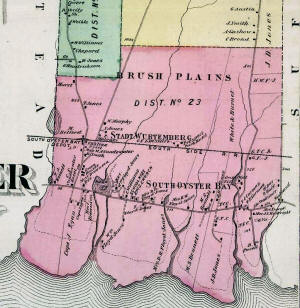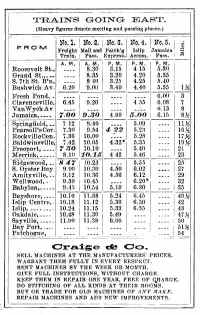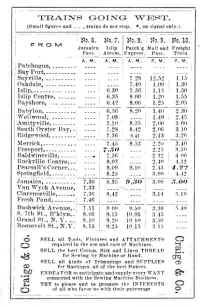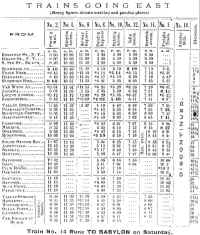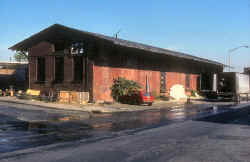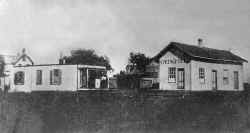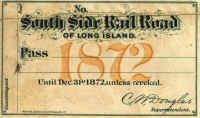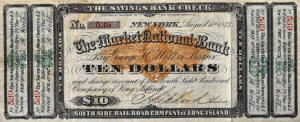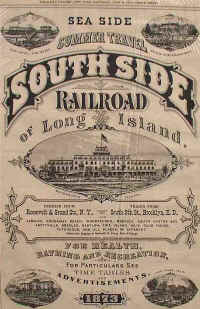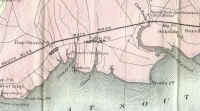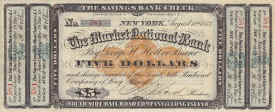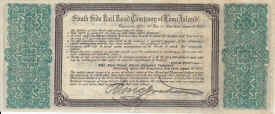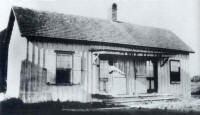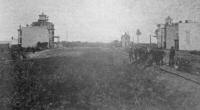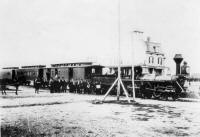The Long Island Rail Road: A Comprehensive History, Part One: South Side R.R. of L.I.
by Vincent F. Seyfried 1961
Foreword

South Side Rail Road 1870 map Archive: Art
Huneke
Although the Long Island Rail Road traces its history back to1836 and is the third oldest line in the country, only two previous accounts of it have appeared: Elizur Hinsdale's brief history published in 1898, and Felix Reifschneider's longer and much fuller work published in 1922. In the forty years that have passed no comprehensive, intensively researched work has appeared.
The present volume seeks to present the full story of one of the Long Island Rail Road's first competitors: the South Side Railroad of Long Island, which operated the present Montauk Division as an independent railroad from 1867 to 1876.
After the lapse of almost a hundred years very few original sources have survived; only a single printed prospectus for a bond issue remains from South Side days. It has been necessary, therefore, to rely heavily on the contemporary newspapers for a day-to-day account of the road. Every surviving newspaper that published in any locality served by the South Side R.R. has been systematically searched for material. These include: THE PICKET, (Rockville Centre), 1865-1870; SOUTH SIDE SIGNAL, (Babylon), 1869-1880; FLUSHING DAILY TIMES, 1875-1880; BROOKLYN DAILY TIMES, 1863-1880; NEWTOWN REGISTER, 1873-1880; LONG ISLAND FARMER, (Jamaica), 1863-1871; LONG ISLAND DEMOCRAT, (Jamaica) 1863-1883. The valuable files of the PATCHOGUE ADVANCE and the SOUTH SIDE OBSERVER (Rockville Centre) for the 1870's are unfortunately lost.
A considerable body of new information on the railroad is brought forward here, much of it not known before. Even with this new accession of information, the reader may sometimes feel that a certain area of the road's history remains obscure; this may well be true, but, barring the improbable appearance of important new sources, we must be grateful that even this much has survived the destructive effects of fire, negligence and the many changes of administration.
It is hoped that this volume will be the first of several successive histories covering the full Long Island Rail Road and its predecessors; a second book on the Flushing, North Shore & Central Railroad is now in preparation. My thanks are due to Mr. William Rugen, who has furnished all the illustrations, and to Mr. Felix Reifschneider, who has read the manuscript, made many valuable suggestions, and arranged for the publication of the work.
CHAPTER I: The South Side RR Becomes a Reality
When the LIRR was first built and opened through to Greenport in 1844, its projectors thought of it as a direct route through to Boston, and somewhat a means of opening up to colonization the endless pine barrens through the center of the island. Historically, however, the oldest settlements on L.I. have been on the western end and all along the south shore. The original line of the LIRR, therefore, once it left Jamaica, passed through an uninhabited wilderness and served none of the old established and populous villages strung out along the south shore. Persons wishing to reach Brooklyn and Manhattan by rail had to make their way along the primitive roads inland to one of the lonely LIRR stations in the center of the island, and as this traffic grew, various stage coach routes sprang up to meet the increasing demand for public transportation. Several lines like the Deer Park-Babylon stage and the Hempstead-Freeport stage ran on regular schedules and carried many passengers.
In the 1850's transportation on the south side was further improved when the Plank Road companies took over the old wagon tracks and converted them into planked toll roads. The Merrick & Jamaica Plank Rd. Co. improved the Merrick Road between Jamaica and Merrick, while the South Oyster Bay Tpk. Co. improved the road from Hempstead to Merrick and on to Babylon (the present Babylon Turnpike and the Merrick Road). By 1860 there was a regular stage coach line between Amityville and Fulton Ferry which made two round trips a week, each round trip occupying three days, the middle day being allowed to rest the horses and to let the passengers transact their business. The stage was drawn by three horses and a relay was kept at Hempstead. It carried the mails for all the villages and the freights.
As the country entered the Civil War era, it became apparent that the stage coach could no longer meet the needs of the growing island. In 1860, therefore, a group of Long Island and Manhattan capitalists resolved to build a railroad from the East River to Patchogue all along the south shore of the island. The directors and president of the LIRR had been approached on several occasions to build such a road, or at least extend branches to the big villages, but they had always refused. It became clear that if a south side road was to be built at all, it would have to be built by independent capital.
Charles Fox of Baldwin was the leading spirit behind the organization of the new road. A wealthy man owning much real estate in Manhattan, a senior partner in the big clothing house of F. B. Baldwin and an alderman in New York, Fox induced a group of other wealthy men to invest in the new project. The Civil War forced the scheme into abeyance until 1865 because of the instability of the money market and the impossibility of obtaining iron. With the coming of peace in the spring of 1865, Fox and his men plunged energetically into the organization and building of their South Side Railroad of L.I. By summer the stocks and bonds of the new road had been printed and were placed on the market. As fast as the securities were sold, the road was to be built and it was hoped that ground would be broken in October.
In the fine Fall weather of 1865 the directors of the road personally visited all the men of means of their acquaintance along the south side towns. Next to Charles Fox, one of the road's most vigorous supporters was Willett Charlick, brother of Oliver Charlick, president of the Long Island R.R., and the deadliest enemy of the whole South Side RR scheme. Willett Charlick lived in Freeport and canvassed that area along with director Samuel DeMott; James Tuttle covered the Rockville Centre area and Martin Willets did the same for Babylon.
Stock and bond sales were slow in coming in. Some persons insisted the road would not pay, while others doubted that it would be built at all. It was hoped to raise by public subscription $250,000 in all. As the year 1865 drew to a close, all but about $40,000 had been paid in.
In January 1866 the road was formally incorporated and it was planned to begin construction as soon as the frost was out of the ground. Naturally enough, Charles Fox was elected president of the new organization; the treasurer was William J. Rushmore, president of the Atlantic National Bank in Brooklyn and a resident of Hempstead, and Alexander McCue, Corporation Counsel of Brooklyn, became treasurer. The vice-president was A. J. Bergen, member of the Assembly for Suffolk.
In March 1866 Oliver Charlick's friend, the "Long Island Star" ridiculed the new road because the articles of association and the maps had not yet been filed, but work went on just the same. Sales of stock continued encouraging and best' of all, many landholders were donating the right of way.
In April 1866 the road was advertised for contract. Sealed proposals were receivable at the company's office at 68 Wall St., New York, for grading, bridging, masonry, furnishing and laying of ties and rails for 34 miles of line from Jamaica to Islip. Plans and specifications were available as of May 1. Samuel McElroy was named Chief Engineer. Bids were to be closed on May 12.
The successful bidders were Shanahan, Meyers & Co. and the contract set April 1, 1867 as the completion date. The contractors started work on May 22 and immediately subcontracted the road into six sections, as follows:
- Jamaica to Springfield, 4 miles
- Springfield to Rockville Centre, 5½ miles
- Rockville Centre to Freeport, 4 miles
- Freeport to Hicksville Rd., Massapequa, 6 miles
- Massapequa to Islip, 15 miles
- Springfield to Rockville Centre, 5½ miles
Vandewater Smith, himself a director of the road and a contractor, was to furnish a third of the ties; Willett Charlick furnished a second third, and Martin Willets of Islip the remainder. Ties had to be 8 feet long, 4½ to 5 inches thick, and 6 inches wide dressed; any wood at all was acceptable. The railroad itself was to furnish the rolling stock.
On Monday, May 28, 1866 the dirt began to fly. A small work force began labor in Jamaica, while a second force was sent to work at Freeport and began grading westward.
In September 1866 at a meeting of the directors it was voted to extend the road from the present contracted terminus at Islip eleven miles eastward to Patchogue. This extension would not be laid, however, till 1867 or 1868; there was also talk of running a steamer from Patchogue to touch all the Great South Bay villages to the east.
During September 1866 additional gangs of workmen were set to work at the Hicksville Road (present Route 107) between the present stations of Seaford and Massapequa and work was pushed two miles to the east and west. Another gang was engaged near Amityville, grading through the swamp north of Ireland's Mill Pond (still existing) and a third graded through the swamp near Carman's Mill Pond (Massapequa Lake).
By the onset of winter weather in late November 1866, the grading of the road bed was largely finished between Jamaica and Islip. It was planned to lay ties and rails in the coming spring. The spectacle of actual physical work on the new railroad spurred the sale of the road's remaining securities, and in December Mr. Willett Charlick made the rounds of the bondholders for the first installment of 33 and 1/3%.
The enforced rest for the winter months was put to good use by the officials of the road in negotiating for a western outlet for the railroad. At first the directors approached the Brooklyn Central & Jamaica RR operating the line between Flatbush Avenue, Brooklyn, and Jamaica, but Oliver Charlick, the astute and Machiavellian president of the Long Island RR, managed to secure an indirect lease on the line for himself in November 1866, and so shut out the South Side R.R. from downtown Brooklyn. This left the road with the alternative of building its own line westward from Jamaica to a terminal in Long Island City or to Williamsburgh. After much deliberation it was decided to do both if possible. Overtures were made to the Brooklyn authorities to enter the Bushwick area via Metropolitan Ave., and to the New York & Flushing RR to lease that portion of their track along Newtown Creek between Maspeth and Long Island City. Since either terminus involved building at least as far west as Maspeth, another contract was let to grade a route through Richmond Hill, Glendale and Fresh Ponds, to be completed by July 1. Work began April 8, 1867. During May Messrs. Shanahan & Shields, the contractors, were busy grading between Maspeth and Glendale.
Meanwhile the more important task of working on the main line was resumed in April. Gangs of men with ties and rails were dispatched to South Jamaica and Springfield. Another gang began work on the eastern end of the road in May. In June enough rail had been laid at the Jamaica end to run an engine and work cars. Old Beaver Pond between Beaver Street and Liberty Avenue in Jamaica presented something of an obstacle to the railroad because of the swampy marshland on its edges; to overcome this the track was laid on driven piles, and the construction cars dumped load after load of dirt into the pond to make a sound roadbed and provide room for a station area and sidings. Orders were placed for three locomotives and the first passenger cars.
Over toward Newtown Creek in Maspeth work was also progressing. The railroad successfully negotiated the purchase of thirty-five acres of meadow land belonging to Calvary Cemetery between Jack's and Dutch Kills creeks with a valuable frontage along Newtown Creek on which to establish a freight and manure depot.
In Fresh Ponds the South Side laborers staged a local riot on pay day June 18, by getting drunk, shouting, insulting passers-by, and eventually forcing their way into houses where they belabored the owners and stole their valuables.
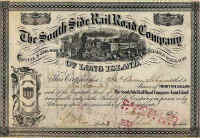 |
South Side
Railroad Stock Certificate Issued: 01/08/1867 Archive: John M. Szabol, Contribution: Art Huneke Collection |
During July 1867 the work of track laying progressed at the average rate of half a mile per day; track laying was going on simultaneously from Fresh Ponds to Jamaica and from Jamaica to about Valley Stream. Another track laying gang was moving west from Babylon. By the third week of August the rails reached Pearsall's (Lynbrook) and then a halt developed because of some difficulty between the officers of the road and Contractor Shanahan.
The work was further handicapped at this moment because of a severe injury to President Fox. He had attempted to board a Long Island train hurriedly at Mineola on the morning of August 5, 1867, moments before it had come to a final stop. In so doing, his foot slipped and he fell between the car and the station platform, the motion of the cars rolling him over and over in a space of seven or eight inches, causing severe internal injuries and breaking an arm. Doctors were summoned immediately who saved his life. A long period of recuperation became necessary and the active management of the road devolved upon one of the directors, Mr. A. J. Bergen of Islip.
During the first week of September the railhead reached Rockville Centre. The engine Charles Fox headed the construction work at this time and the south siders felt elated at the spectacle of this new iron horse puffing along, backing and returning; thirty to forty men were at work moving the railhead eastward.
By September 10 two engines were running construction trains, and two new passenger cars had been delivered at Hunter's Point; ten miles of track remained to be laid. At a meeting of the directors Mr. Ezra W. Conklin received the post of Chief Engineer replacing Samuel McElroy. On Monday September 23 the completed railhead reached the village of Freeport and the citizens went out of their way to welcome the construction train. All the residences were lighted up and a large number of people gathered at the railroad crossing at Main Street. Here sat the Charles Fox steaming away under an imposing arch bearing the inscription "Welcome to the Charles Fox," and on either side of the arch was suspended the Stars and Stripes. At the rear were the flat cars which served as platforms for the speakers and the brass band. Transparencies hung here and there adding a light and gay touch to the street. Decorations of evergreens and floral designs hung from poles all about and fireworks lit up the evening sky. Suitable short speeches were made and cheered to the echo, after which refreshments were served.
| SSRR South Oyster
Bay Depot map -1873
|
Five miles of rails remained to be laid. On October 11, 1867 the rails reached Babylon, and on the following day the Charles Fox with a passenger car attached containing the directors, passed over the road and were the recipients of numerous ovations at the different stations along the route. A brass band turned up at the Mineola Hotel where President Fox lay, recovering from his injuries, and serenaded him and he responded by inviting them all in for supper.
On Monday, October 28, 1867 the great day arrived, and trains began running regularly for the first time. The first trains enjoyed heavy patronage and met enthusiastic receptions all along the line. The very first schedule provided for two trains a day each way, one in the morning and one in the afternoon. The running time was one hour and fifteen minutes and the stations and fares were as follows:
| Jamaica to | ||||
| Springfield | 15¢ | Merrick | 45¢ | |
| Pearsall's | 25¢ | Ridgewood (Wantagh) | 55¢ | |
| Rockville Centre | 30¢ | South Oyster Bay (Massapequa) | 60¢ | |
| Baldwinsville | 35¢ | Amityville | 65¢ | |
| Freeport | 40¢ | Babylon | 85¢ |
The opening of the new road was acclaimed in all the Long Island newspapers and many persons turned out to see the new first-class locomotives and elegant passenger cars. A month before (September) the directors had succeeded in inducing Robert White, superintendent of the LIRR, to take over the same post on the South Side R.R. He was one of the most experienced railroad men available and brought to the road the energetic and competent management it needed.
On November 14, 1867 the South Side R.R. staged a formal grand opening of the completed road between Jamaica and Babylon. A five-car train was drawn up at the station and filled with the mayor, the whole Common Council, and prominent people of Brooklyn, plus the officers and directors of the South Side R.R. Other cars contained the prominent officials of Jamaica and Queens County, some Assemblymen from Albany and gentlemen of the press. The weather providentially turned out sunny and clear. After an hour's ride the train reached Babylon and the party was escorted to the American Hotel where "an elegant and sumptuous repast" was served. Speeches were made by the more prominent guests and the health of the absent President Fox was toasted. Later the guests sauntered about the streets of Babylon and then "took the cars" for Brooklyn.
Among the lyrical predictions of great things to come from the opening up of rich farmlands and thriving villages, many interesting facts emerged. The road cost $20,000 a mile including equipment; the company's capital was $1,250,000, of which $700,000 had already been expended. Popular enthusiasm along the line had resulted in the donation of several depot buildings. At Ridgewood (Wantagh) the depot had gone up by private subscription and the same thing was being done at Babylon. In addition much of the right of way had been donated outright by the farmers.
CHAPTER II: The South Side Rail Road Reaches the East River
While the company was completing its main line to Babylon, important events were happening on the west end of the line during the spring and summer of 1867. When the railhead approached the headwaters of Newtown Creek, it became necessary to make a decision: should the road seek its river-front terminal by going along the north bank of the creek into Long Island City, or should it follow the south bank into the Williamsburgh section of Brooklyn? Since the Long Island RR and the Flushing RR already had their termini in Long Island City, the company favored Brooklyn for its depot.
As early as the fall of 1866 long before the road turned a shovelful of earth, some of its promoters induced some of the prominent residents of Williamsburgh to support them in a petition addressed to the Common Council of Brooklyn to enter the city along the line of Metropolitan Avenue and North Third Street down to the ferry, and with a main depot at Union Avenue. The residents of the then very new village of Greenpoint signified that they were more than willing to let the railroad come through their area, should Brooklyn prove inhospitable.
Williamsburgh at the end of the Civil War had grown into a large city; between 1850 and 1855 it had been an independent city and had then merged into Brooklyn as the Eastern District. The Common Council was understandably hesitant about permitting a steam railroad to lay its tracks through a densely settled area where there was menace to life and limb. The Council wisely decided to open the question to public discussion and advertised public hearings in the press. The editors of the local papers seized upon the topic as one of paramount importance to the community, and threw open their columns to the widest public discussion.
Thanks to the long series of articles contributed by every shade of opinion, we can appreciate today the feelings pro and con about steam in the streets. In the Williamsburgh of the 1860's Bushwick Avenue, a north-south street, marked the limit of settlement. East of Bushwick Avenue stretched a very large area of swamp and meadowland forming the headwaters of Newtown Creek. No houses dotted this primeval greensward. Farmers pastured their cows in its fields and cut hay for winter fodder. Two roads only cut through the meadows: Maspeth Avenue and Metropolitan Avenue.
On the edge of the meadows and near the junction of the above avenues stood the old-time glue factory of Peter Cooper, one of the merchant princes of his day and the founder of Cooper Union. He owned nearly all the land in the area, while the Thursby family of ropewalk fame and the Kalbfleisch family (mayor of Brooklyn) owned the rest. The Coopers vigorously opposed the incursion of the South Side RR and led the opposition against the road. Cooper alleged that 100% of the people were opposed to the railroad and in rebuttal angry letters appeared in the Times attacking Cooper for self-interest and inaccuracy. The controversy raged unabated during May, June and July 1867 and finally came to a head in November and December.
Briefly, opponents of the South Side RR made these telling points against a line on Metropolitan Avenue to the ferry:
- Travelers from Long Island would simply pass through Williamsburgh and not spend any money in the District.
- The District contained twelve churches and three large public schools, the pupils of whom were threatened with maiming and death at the hands of the railroad.
- Steam cars would inevitably depress the value of building lots just coming onto the market.
- Steam would blight the residential area between the ferry and Bushwick Avenue, as had happened on Park Avenue and Eleventh Avenue in New York.
- The speed of steam cars will be greater than that of horse cars and so be a greater menace to pedestrians.
- A depot on the East River would crowd existing factories, and the trans-shipment of manure would make the area intolerable to residents.
- Metropolitan Avenue was narrow, twenty-four feet in some places and sixty feet at most anywhere, leaving no room for vehicular traffic.
-
Metropolitan Avenue varied widely in grade; a steep rise from the ferry to Bedford Avenue, a deep dip near Union Avenue, etc. The grade varied eight feet over all and because nineteen streets intersected it, cutting it down to a level for steam engines would be unthinkable.
Proponents of the South Side Rail Road urged these points in answer:
- Peter Cooper's opposition stems from his unwillingness to move his pestilential glue factory.
- A large produce market would be set up at the South Side terminus as an outlet for the Long Island farmers, providing fresh produce for all and employment for many.
- The railroad will not depress, but will rather increase the value of property along the street.
- Streets with railroads hum with life but wither away with the driving out of steam traffic; see what Atlantic Avenue was before 1861 and what it is now.
- Opposition to the South Side RR is being secretly abetted by President Oliver Charlick of the LIRR who fears competition, and the owners of the Long Island City ferries who fear loss of patronage.
- Quick, cheap transit to the suburbs is one of Brooklyn's crying needs.
- Access to Long Island summer resorts and beaches will be a boon to every Brooklyn family.
- Progress cannot be stopped by a Japanese policy of a closed door.
- The distance the railroad would go through crowded city streets is only a half mile to a Union Avenue depot or a mile to the ferry.
As the argument raged in the hearings and in the press, the local newspaper carne out strongly in favor of the South Side road. The Brooklyn Times and the Brooklyn Union championed the railroad, and the Eagle favored the idea. There were not wanting voices of compromise. Some suggested running the road to the Wallabout Basin (now the Navy Yard) along the lowlands marking the division between old Brooklyn and Williamsburgh, approximately along the line of Flushing Avenue, then sparsely settled. Another school of thinking viewed favorably a private right-of-way running midway between Maspeth and Metropolitan Avenues as far as Bushwick Avenue. Still others liked the idea of a line along Newtown Creek down to the East River by-passing Williamsburgh altogether.
In the first week of July 1867 the hot dispute came to a vote in the Common Council and the railroad was refused entry into Brooklyn along the line of Metropolitan Avenue with steam cars. In September the South Side RR again petitioned the Common Council to enter Brooklyn, this time along the line of Dickinson Avenue, then north up Vandervoort Avenue to Orient, and west along Orient Avenue to the jnuction of Metropolitan and Bushwick Avenues. This route was poor, involving two sharp turns, yet opposition again developed despite the absence of houses along the route.
As November 1867 wore on with no solution in sight, the Brooklyn Times editorially suggested that the South Side might achieve a river terminus cheaply and easily by going along the line of Bushwick Creek (North Thirteenth Street and through McCarren Park), the very route later to be chosen for the Manhattan Beach road, but intimated that the railroad should be satisfied with a depot on Bushwick Avenue.
The South Side RR made one last try before accepting the advice of the Times. On November 28, 1867 the road petitioned the Common Conucil to enter Brooklyn along the line of Montrose Avenue and to build a depot at Union Avenue. The advantages were that Montrose Avenue was eighty feet wide in Williamsburgh and that east of Bushwick Avenue, it existed only on paper, traversing a swamp and meadow with not a single house. From Bushwick to Union Avenue was densely populated, to be sure, but this stretch was only five blocks long.
No one at all objected to the meadowland route to the east, but for the five block stretch to Union Avenue there was strong opposition because of the dense population all about; all the old arguments against steam were trotted out and restated. Some one proposed a tunnel but the railroad engineers pointed out that the ground level was only seven to ten feet above high water and that the railroad was unable to expend the estimated cost of almost a million dollars.
As the year 1867 came to a close with the matter still deadlocked, the railroad accepted what had long been apparent: a terminus on the edge of the city (Bushwick Avenue) and the use of horses to pull the cars the rest of the distance to the ferry. As soon as the railroad made known its willingness to accept this compromise, the Common Council on December 16 gratefully ended the long dispute by granting a depot on Bushwick Avenue at Montrose Avenue and a single-track horse-operated road to the ferry at the foot of South Seventh Street.
When it became evident to the South Side RR that an outlet to the East River was certain, negotiations were begun to acquire a site on the waterfront for a depot. The company first negotiated for the Tuttle Coal Yard at Wythe and South Seventh but the price of $33,000 for 3 lots struck the directors as too high. The ferry stand at the foot of South Eighth Street, and a lot at South Eighth and Kent either cost too much or else provided insufficient space. After much searching about, the railroad finally managed to buy a plot of ground directly on the water between Broadway (old South Seventh Street) and South Eighth Street. The site had formerly been a coal yard and the railroad simply took over the existing office building as a freight depot. The property consisted of eight city lots, with a frontage on Kent Avenue of sixty-eight feet and a depth of 156 feet. Since the property directly adjoined the Broadway Ferry, it provided ideal accommodations for passengers.
With the depot problem solved at last, the South Side RR lost no time in building its track from Jamaica to the Broadway Ferry. As of December 1867 the track was completed from Jamaica to 118th Street., Richmond Hill, and the iron and ties were distributed along the line as far as Fresh Pond Road only three miles from the South Seventh Street ferry. The hard frosts and winter weather made track laying unsuitable, so the company used to good advantage the months of February and March in securing a route between Bushwick terminus and South Seventh Street ferry. On February 20, 1868 a petition was presented by the owners of property on Broadway to permit the railroad to run horse cars on Broadway. On March 2 the Common Council granted this request, giving the South Side a line along Montrose Avenue from Bushwick Avenue to Union Avenue, down Union Avenue a block to Broadway, and thence along Broadway to the ferry. The only conditions set were that the company should pave the rails with stone, operate only steam coaches, not park cars in the public street, and transport no manure.
While this arrangement seemed to please everybody at first sight, there was one hidden flaw. The Broadway R.R. Co., a street car company, was already operating a line of horse cars along Montrose Avenue to Bushwick Avenue. Rather than lay a second track beside that of the Broadway Company, or enter upon long and involved negotiations with them, President Fox of the South Side petitioned the Common Council to substitute Boerum Street instead, two blocks to the south. This time, miraculously, the permission was forthcoming immediately without long and dreary litigation.
With the entire route to Brooklyn cleared at last, the contractors building the road pushed their work. Just at this juncture, President Oliver Charlick of the LIRR shrewdly introduced another obstacle. As lessee of the Brooklyn Central & Jamaica RR since 1866, Charlick secured an injunction from the courts to prevent the South Side RR from crossing his road at Dunton west of Jamaica. It was but a delaying maneuver at best and within a month's time, the injunction was dissolved and construction continued onward.
By February 15, 1868 the gang had completed the track to Fresh Ponds and it was debated whether to open service immediately or wait to reach Brooklyn. On the nineteenth, as a party of workmen were excavating in a cut west of Fresh Pond Road, the bank suddenly caved in burying three men; thanks to prompt rescue work, all three were dug out uninjured. During April another gang was hard at work driving piles along the route through the meadows adjoining Newtown Creek. All during the fair spring weather the work was being pushed night and day and it was announced the road would enter Brooklyn by June 25. The heavy cutting involved in passing the ridge of hills near the Lutheran Cemetery proved the biggest obstacle.
On Saturday, July 18, 1868 the great day arrived after months of preparation; the first train passed over the South Side RR into Bushwick station, carrying 600 passengers. As yet there was no real depot. The railroad had taken over a farmhouse of Revolutionary vintage on the property, once the homestead of the Schenck family, and used it as a temporary waiting room and ticket office. The railroad had to rely on the Bushwick Avenue and Montrose Avenue horse cars to transport its passengers to the ferry, and there was lively competition for this privilege between the Brooklyn City and Broadway Railroads.
The opening of the South Side line to Brooklyn was welcomed as one of the greatest events in the history of Williamsburgh. The press saw it as a final rectification of the blunder of driving steam service from Atlantic Avenue seven years before. It was now possible to reach Jamaica in twenty minutes less time, and more important, brought the whole of the south side of Long Island into easy reach of Brooklyn. The new equipment and high standard of roadbed was favorably contrasted with the older Long Island RR, and looking far into the future, the press envisioned the many new villages and handsome residences that would grow up.
Even with the completion of the line into Bushwick, all did not run smoothly. In three days' time no less than four attempts were made to wreck the train by placing obstacles on the track; then on July 24 a torrential rain covered the track of the road with sand and water near Fresh Ponds and prevented service for half a day.
Laying of the rails into the ferry building was beset with difficulties. A sewer was being constructed along lower Broadway and the road was forced to wait till the work was done; in addition a horse car company operating on Union Avenue had been granted a terminus at South Eighth Street, and, as laid out, the railroad tracks and horse car rails would cross one another six times near Kent Avenue. To get out of this difficulty the South Side RR again appeared before the Common Council to exchange a portion of the two company's respective routes.
The permission to exchange track locations was easily forthcoming, but the Aldermen tacked on as a rider a prohibition against the use of T rail on Broadway, a right granted to the road in the earlier statute passed by the Council. Since part of the route was already laid with T rail, this eleventh-hour denial posed a new problem.
In the last days of September the tracks were laid through Boerum Street, and at the same time a large and commodious depot was going up at South Eighth Street. By the first week of November 1868, the work was almost completed; on November 4, Wednesday, the first train made the maiden trip through Brooklyn streets to the ferry terminus, eliminating at last the delay and inconvenience of changing cars at Bushwick. The South Side RR had at last reached the East River.
The South Side was not wholly satisfied with the new arrangement. Because the cars were drawn through Boerum Street and Broadway by horses, a train had to be broken up into individual cars, and a six-horse or eight-horse team attached to draw each coach to the ferry. In the railroad's view this process was cumbersome and increased the chances of accident. Using a steam dummy seemed the best solution.
Nothing quite like the old-fashioned steam dummy exists today; perhaps the closest modern analogy is the little diesel switcher popular in rail yards and freight terminals. In size the steam dummy resembled a small horse car of the period. It was very short with the conventional five or six windows and inside was a vertical steam boiler with a smokestack extending out through the roof. It had but four wheels driven directly by a piston and connecting rod from a small cylinder located near the front wheel. Because the engine ~was small and not very powerful, its smoke and cinder exhaust was small and hardly objectionable. Its chief advantage for the South Side RR was that it could haul a whole train of the frail wooden coaches of that period without the necessity of breaking up the train.
The use of steam through city streets necessitated another campaign of persuasion not only in the Brooklyn Common Council, but also in the State Legislature. Early in November 1868 the company applied to the Council for permission to experiment with a new dummy engine, to see whether the current models could draw cars on the grade along the eight blocks of South Eighth Street. The Brooklyn Times again took up the company's cause in its columns and urged the reasonableness of the idea.
A public hearing was called on December 3 and after much discussion, the use of a dummy was voted down. The chief objections were that steam engines were a threat to the safety of children, that they depreciated property, and created smoke. Most persons had no clear conception of the difference between a steam engine and a dummy, although company representatives stressed that the dummy's speed was only four to eight miles per hour and that seven to eight cars could be drawn at one time, and stopped within the dummy's own length.
When the Common Council met to consider the question, no remonstrance had been received from the property owners. The council members advised the road that if the company would substitute the groove rail for the present T rail, the matter might receive more favorable attention. Complaints had been received about wagons breaking axles. The railroad's representatives replied that an order had already been given to a Jersey factory for the grooved rails, but the order had not yet been filled. The Aldermen seemed dissatisfied at this and voted to leave the matter in abeyance till the rails were changed. On December 28 the matter was again brought up and permission at last given. The grant expressly stated that experimental trips only might be attempted on three days in January 1869, and as a further precaution, insisted that the engine be preceded by a horse with rider carrying a red flag; that bond against damages be executed, and that the T rail be eliminated at the earliest possible moment.
The South Side RR was not the first to try out steam dummies as a substitute for horse power. It had been tried intermittently on certain New York street car lines in 1864 (Second Avenue and Bleecker Street), in Philadelphia later, and in 1868 on Atlantic Avenue by the Atlantic Ave. RR Co. The New York & Hudson River RR was also using one on Eleventh Avenue in New York which the Brooklyn Aldermen themselves visited in January 1869. As a result of this visit the officials were very favorably impressed and renewed the South Side Rail Road's permission to test their engine in February, nothing having been done in January. In a burst of generosity they even withdrew the requirement to employ a horse and a red flag.
As soon as the permission was forthcoming, the South Side officials scouted around everywhere for a suitable dummy engine and found none for sale. As the weeks drifted by, it became necessary to place an order for an improved dummy with a firm in Jersey, and to petition the Common Council for an extension of time. With an eye to the future, the company also introduced a petition to the Assembly in Albany on March 11, praying for permission to use the dummy permanently in the streets of Brooklyn. On April 20 the bill was passed by the Assembly and referred to the Senate. Oliver Charlick of the Long Island~ RR and men of influence on the Long Island's Board of Directors were busy using every political connection they enjoyed to defeat the measure.
From a newspaper attack on the South Side RR in April led by a citizen of Williamsburgh, we learn that the company had failed to remove the T rail although it had promised to do so as soon as the frost was out of the ground. It was true that the new flat rails were stacked all along the curb in Boerum Street and Broadway, but no effort had been made to lay them. The writer bitterly denounced the double nuisance of T rail in the road and the obstruction to the sidewalk of the grooved rails; he pronounced the condition of lower Broadway so wretched between South Eighth and Boerum Streets that for eight or ten blocks the avenue was virtually closed to light carriages. The editor's comment did not disagree with these facts and expressed the hope that the South Side people would be stirred to action.
The letter must have been effective for during the first week of May the company removed a part of the T rails from Broadway and were installing the grooved rail to the pleasure and satisfaction of carriage drivers. The work proceeded at an irritatingly slow pace all during May and June and the discarded T rails lay in piles in the roadway, narrowing Broadway for wagon traffic.
Apparently the Senate Railroad Committee reported favorably on the dummy bill despite Charlick's machinations, for the company made ready all during June and July for the new dummy service. On Saturday July 31, 1869 a dummy made a trial trip at four P.M. along Boerum Street for the first time. It came down with four passenger cars and four freight cars. The trip took about ten minutes and closely observing the operation were President Fox and Superintendent White in one of the passenger cars. On Monday morning, August 2 the dummy began regular service hauling full trains back and forth. After a week of operation no accidents had occurred and no complaints lodged, moving the newspapers to comment on how groundless and old-maidish had been the fears of alarmists.
CHAPTER III: The Era of Expansion: Patchogue, Rockaway And Hunter's Point
With the all-important deep-water terminus in Brooklyn secured, the South Side RR next bent all its efforts to completing the east end of the line. Originally, the company had planned to build only as far as Islip, but it quickly became evident that the much larger village of Patchogue would make a better terminus. Long before the first train opened regular service to Babylon on October 28, 1867, the inhabitants of the south shore villages were actively discussing just how far eastward the railroad should be extended. While the directors of the road were perfectly receptive to the idea of building farther afield, Patchogue seemed an immediate and practical goal.
The contract for grading the roadbed east of Babylon seems to have been given out as early as January 1868. By the last week of March the engineers' surveys were completed, and grading was planned as soon as the ground thawed sufficiently. On April 2, 1868 track-laying between Babylon and Patchogue was commenced, and on April 30 was completed as far east as Islip. It was tentatively planned to open service to Islip on May 1; workmen meanwhile hastily pushed on toward Patchogue. By August the grading had been completed to Sayville and grading between here and Patchogue was begun. In the first week of September workmen began laying the rails eastward from Islip and on Saturday, September 5, trains were run into the village of Islip for the first time.
Grading meanwhile had been pushed to within a mile of Patchogue. By September 10 the grading gang had passed Sayville. As a temporary measure arrangements were made with the proprietor of the stagecoach running along the Montauk Highway to carry passengers from Patchogue to the end of track. On September 7, Labor Day, no less than eighty passengers were so conveyed, something of a record for so small a vehicle on one day and almost a century ago. By September 21 the grading had approached to within a mile and a half of Patchogue. As autumn passed on into late October, the railroad came close to Sayville and the grading work into Patchogue reached completion; Superintendent White announced to the newspapers that service would begin to Sayville "in a fortnight."
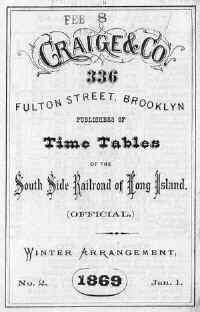 |
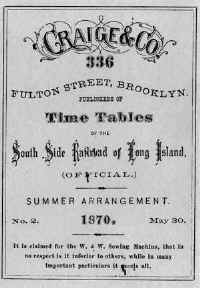 |
In the first week of December Jack Frost put an end to all grading operations for the winter, but on or about December 11 Superintendent White did inaugurate the service to Sayville station as planned. So pleased were the residents of the town at having the trains before winter closed in that on Sunday the thirteenth, a large group of townsmen joined fifty of the railroad's employees in erecting and completing an engine house all in one day. Work necessarily came to a halt during the coldest winter months, but in March the railroad resumed work on the road, and pushed it as fast as the ground would allow. Finally, on or about April 10, 1869 the line was completed to Patchogue. One would suppose that the completion of the main line would have occasioned some sort of celebration, but the event must have been a quiet and casual affair, for it passed unchronicled in any of the newspapers of the island.
The mere presence of the South Side RR was a stimulus to all the villages along the south shore from the very day that the road had been organized. In an age when railroad facilities were a prestige symbol for a town and meant the difference between isolation and partnership with progress, forward looking townsmen and merchants in every village took it upon themselves to initiate promotion campaigns and to offer tempting inducements to railroad boards of directors to extend to their locality.
As early as January 1867, long before the first tie had been laid, the citizens of Moriches held a meeting and voted to grant the right-of-way through their land to the company. Not to be outdone in generosity, the landowners near Sag Harbor offered the same inducement in March. To smooth the advance of the railroad legally, committees arranged for the presentation to the Legislature of bills authorizing extension of the road through the Towns of Brookhaven and Southampton, and offered to market railroad bonds to the amount of eight and ten thousand dollars per mile of road built.
During the winter months of 1867-8 rallies were held in the principal villages to whip up railroad enthusiasm and in April the three townships of Brookhaven, Southampton and Easthampton came through handsomely with generous offers of money and land. Brookhaven offered $68,000 and the right of way, Southampton $112,000 and the right of way, and Easthampton $25,000, a grand total of $205,000 toward the completion of about forty-five miles of road eastward from Patchogue to Sag Harbor. This generous offer was presented to the directors of the South Side RR at their meeting on April 6, 1868 and unanimously accepted.
With the coming of spring in 1869, it was reliably reported that the directors were about to build along the proffered right of way from Patchogue through Bellport, Brookhaven, and Moriches to Riverhead, the county seat. The inhabitants of Riverhead declared themselves ready to vote $25,000 or more to encourage the enterprise.
Whatever the reason, nothing so grandiose as a Riverhead extension took place over the summer, but in the fall of 1869 commissioners were appointed to appraise the damages to property for a four-mile extension from Patchogue to the neighboring village of Bellport, in the hope that construction could begin in the spring of 1870. The people of Moriches, at a public meeting, also took the occasion to appoint a committee to wait upon President Fox of the South Side RR to persuade him to build as far as Eastport, the easterly limit of the Town of Brookhaven. President Fox replied that the request would be favorably considered, provided the residents along the proposed extension would subscribe for $140,000 of the first mortgage bonds of the railroad. At a meeting of the directors on the twenty-second it was voted to make a survey of the road.
In January it was reported that the $140,000 of stock had all been taken by the residents of the various villages, and that the engineering survey was being pushed. Then, oddly enough, all talk of eastward extensions ceased, and we hear of no further attempts either on the part of the villages or the railroad to move eastward. It is difficult to see after the lapse of a century just why this was so. We can only surmise that the tempting offers of stock and land were not as readily forthcoming as the railroad was led to expect, or, more likely, that the Long Island Rail Road's hasty extension to Sag Harbor just a few months later on June 8, 1870 siphoned off what little traffic originated on the east end.
The directors of the South Side RR were too astute and forward looking however, to waste the season of 1869 in idleness. From the very earliest days of the incorporation of the road, they had cast an appraising eye on the traffic possibilities of the Rockaways, as yet untapped by the Long Island RR. Before the Civil War, surf bathing and beach visiting were virtually unknown; it is difficult to imagine in our day when sun bathing and swimming have become a national cult and part of the mores of American society, that great beaches like Coney Island and Rockaway, only a few miles from the metropolis, were deserted and barren sand dunes.
In 1816 the Pavilion, the first seaside resort hotel in Rockaway opened its doors. During the 1830's visiting the Pavilion became fashionable, but not for the bathing facilities available. Persons of wealth boarded at the shore, ate quantities of "Rockaways," the most esteemed clams of that day, and attended cotillions and concerts in the evening. Life had a leisurely and aristocratic flavor, and none but the wealthy could afford the long, costly trip to the beach.
When the Pavilion burned down in 1863, it marked the end of an era. Hitherto, to get to Far Rockaway, one took the train to Jamaica, and then hired a stage coach to traverse the swampy stretches of the Jamaica & Rockaway Turnpike Co. (Rockaway Boulevard) to the shore. In October 1865 this primitive mode of travel was rendered obsolete by the opening of the Brooklyn and Rockaway Beach RR from East New York due south to Canarsie, where the traveler boarded one of the railroad's launches to anyone of three landings, presently corresponding to Beach 111th Street, Beach 103rd Street and Beach 92nd Street.
The effect of the Canarsie route was to attract traffic to the present Hammel's, Seaside and Rockaway Beach and away from Far Rockaway. A further injury occurred in 1866 when the spring tides caused a long sand bar to form opposite the old Far Rockaway Beach about half a mile out in the water. The bar gradually grew and cut off the breakers, ruining surf bathing. In April 1870 the same spring tides in the course of one evening swept over the island and washed it away to the great joy of the inhabitants, who prayed for a return of the old days when Far Rockaway was known as one of the best surf bathing beaches in the country.
The vast increase in population in Brooklyn and Williamsburgh during the 1860'S because of the record immigration of Irish and Germans is another factor that must be considered in explaining the sudden popularity of the beaches in the late Sixties and early Seventies. These city dwellers lived closely together, raised large families, and worked six days a week; it was inevitable that cheap recreation would attract an overwhelming patronage.
With this potential bonanza in mind, the directors of the South Side RR resolved in 1868 to be the first to build a direct, overland route to the Rockaways. Because the charter of the South Side RR did not expressly permit the construction of a branch to the Rockaways, the directors had to incorporate a subsidiary called the "Far Rockaway Branch Rail Road Co. of Queens County." with Vandewater Smith, one of the directors, as its president.
On March 24, 1869 three hundred men were put to work at a point then known as Wood's Corner, near the Brush Farm, later Franklin Ave., Valley Stream. At almost the same time Electus B. Litchfield, the wealthy railroad magnate of Brooklyn and Babylon, purchased the whole J. N. Brush farm of eighty-five acres in all, for about $20,000 and laid out what became the village of Valley Stream. In the early days of April the work on the new branch accelerated; at the time 160 laborers had graded two miles of road, and on April 10 began laying the ties and rails. By the first of May the whole road had been graded.
Some of the right of way must have been secured by the issuance of lifetime passes to the property holders. We learn this indirectly from an amusing incident that occurred in the fall of this year 1869. An old man, a Mr. Norton, venerable with white hairs, took his seat in the coach with his aged wife. Something evidently excited the old man, for in an undertone he was laying down the law to his companion accompanied with violent gestures. When the conductor arrived, his excitement seemed to culminate. On inquiry it developed that for certain considerations President Vandewater Smith had bargained to allow Mr. Norton and his wife a free pass over the Rockaway and South Side Railroads during their natural lives. The trouble of the old man was that his pass was only dated for one year and had to be renewed each year, whereas he wished it to be perpetual without the burden of renewing it annually.
Just when the progress of the road was all that could be desired, a hitch developed in relation to some real estate. A Mr. William B. McManus who owned a farm located between Rockaway Turnpike and Washington Avenue, Lawrence, and which would be cut in two by the railroad right of way, refused to accept the railroad's valuation on his property, and successfully petitioned for an injunction on May 30, 1869.
This was a severe blow to the railroad's hopes for they were bending every effort to open the line in time for the summer patronage; in desperation they formulated an emergency plan to run trains as far as the McManus property, and convey passengers the rest of the way by stagecoach. By a legal quirk this proved unnecessary; McManus' injunction against the South Side RR expired at 11 A.M. on June 24, and before McManus had time to have it renewed, a force of about seventy men laid the ties and rails over the 7oo-foot distance within three hours and a construction train ran over it. The railroad hoped to surface up and level the track and roadbed over the weekend of June 26-27 and then begin service.
McManus had probably not realized that the railroad was capable of such sharp dealing, but neither did the railroad realize the sort of man they were dealing with. The following night McManus rounded up a group of fellow Irishmen and not only tore up the 700 feet of track, but did it so thoroughly that every rail was ruined in the process of removal.
The railroad was jolted by this unusual show of spirit and began proceedings to discover the culprits. The following weekend McManus was arrested on a complaint of Vandewater Smith, president of the Far Rockaway Branch RR, on charges of malicious and willful destruction. McManus was discharged on a legal objection that the complaint did not state facts sufficient to bring the defendant within the provisions of the statute. President Smith objected to dismissing the suit and a new hearing was scheduled.
Meanwhile McManus' counsel threatened that he would sell or otherwise dispose of the track and crossties if not removed from the premises, and this so alarmed the railroad that they secured an injunction from the Supreme Court forbidding any tampering with their property until final adjudication.
At the next court hearing three commissioners were appointed to assess the McManus property and to make an award. On July 23, 1869 the commissioners inspected the land and after conferring, confirmed an award of $425 to McManus. Predictably, that gentleman flew into a rage and planned to appeal from the decision. Meanwhile, the railroad relaid its ravaged roadbed on July 28.
On Thursday, July 29, 1869 the branch road to Far Rockaway was opened to the public. The importance of the new route could hardly be overestimated. For the first time Rockaway was brought into direct communication with Brooklyn, and it became possible for the average man to visit the beach for the day after traveling for only forty minutes. The total investment for the company came to about $75,000, but it was hoped that the returns would be many times that sum.
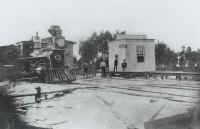 South Side Rail Road - Far Rockaway Archive: Art Huneke |
The South Side RR terminal depot and roundhouse in Far Rockaway occupied the present site of the Long Island RR's depot facing Mott Avenue. Because the South Side terminal was at the north end of the village of Far Rockaway, passengers still had the long distance of a mile to walk to the bathing beach and had to compete for space with the boarders of the many hotels in the village. West of the present Beach Twentieth Street there were no houses or hotels, and the beach and sand dunes stretched for miles; it occurred to the railroad directors that simply by constructing a sweeping curve along the north and west of the village, they could have a terminus right at the water's edge with a beach of their own.
With this object in mind the road initiated fresh construction in July 1869. By the end of August the required one mile of track was completed to the dune headlands between Edgemere and Wave Crest and terminating at a point which today is approximately Beach Thirtieth Street and the Boardwalk. On September 1 the new spur was completed and excursion tickets were put on sale for September 2, entitling the purchaser to a round trip ride, a free lunch and participation in a clambake, in honor of the inauguration of the new line.
On Thursday, September 2, 1869 the new road was opened as planned. President Charles Fox of the South Side RR and Vandewater Smith of the Far Rockaway Branch road, along with many directors and their families, came down to the beach and filled the large tents surrounding the clam pits. Lunch was served to about 200 guests of the railroad present and short speeches were made by the two presidents to mark the occasion, followed by an inspection of the neighborhood. During the following spring of the 1870 season the railroad erected a large restaurant or pavilion 125 x 200 feet on the beach facing the ocean for the convenience of its patrons. Connected with it was a kitchen and rooms for the keeper and his family. On timetables this structure was first referred to simply as "Beach," later "Beach House," and after 1872 as "South Side Pavilion."
By the summer of 1870 the South Side Pavilion was in full operation. There was a large "saloon" where individuals or parties could buy a substantial meal at popular prices, or if they preferred, could occupy guest tables at a rental of twenty-five cents. A string band was provided by the railroad every afternoon for persons wishing to dance. On the beach side there were bath houses, where the railroad rented out bathing suits and extended facilities for checking valuables. A plank walk led from the open depot tracks to the water's edge. So proud was the railroad of its Beach House that it ran another private Rockaway excursion for its board of directors on August 3, 1870.
In **1871 the railroad entrusted the management of the South Side Pavilion to professional operators, Messrs. Hicks & Dibble. On June 5 the place was officially opened for the season and the railroad again ran a private excursion consisting of three coaches and the locomotive "J. B. Johnston" for the benefit of railroad executives, politicians and guests, all of whom partook liberally of the clam roasts and clam chowders for which the house was noted, and later regaled themselves with the yachting and bluefishing facilities.
As the 1871 season wore on, the directors resolved on a new and still more impressive improvement; this was to extend the tracks westward from the South Side Pavilion all the way along the Rockaway peninsula as far as the limit of habitation.
One motive behind this extension was to capture all the Rockaway passenger traffic which up to then had been shared with the Brooklyn & Rockaway Beach RR Co., operating from East New York to Canarsie. While Far Rockaway was an old seaside resort of half a century's standing, the peninsula itself had been slowly developing and was in 1870 the exclusive preserve of four or five hotels. In 1856 James S. Remsen of Jamaica bought a considerable tract of land at Rockaway Beach for $500. In this primitive wilderness he built a little barroom and chowder house, which over the years gradually developed into the Seaside House.
At first the house catered only to fisherfolk and boat parties, but after the Brooklyn & Rockaway Beach RR opened in October 1865, a bay landing was constructed at Remsen Avenue (Beach 103rd Street) and the railroad's ferry boats disgorged Rockaway's first beach crowds visiting just for the day, and intent on swimming, picnicking and gargantuan clam and oyster-eating orgies. Remsen sold some of his land for enormous sums and rented out the rest, including the Seaside House, which, by 1869, was the largest establishment along the dunes. It was this seaside resort that exerted a magnetic appeal on the directors of the South Side RR, and it was towards this goal that fresh construction began in April and May 1872.
There was a second and more immediate motive for building the beach extension in 1872, the unpleasant fact that Oliver Charlick of the Long Island RR was building his own Rockaway Branch from Rockaway Junction (present Hillside station) southward to an undefined point. Unless the South Side RR built immediately westward from their pavilion, their rival Charlick would beat them to the punch. Work was rushed on the new line, which was laid along the highest point of the beach ridge, affording a fine view of the ocean.
On July 4, 1872 the new line opened through to the Seaside House (Beach 103rd Street, Seaside Station). There were two intermediate stations: Eldert's Grove (Beach Eighty-fourth Street, now Hammel's) and Holland's (Beach Ninety-second Street, now Holland Station). Both of these were resort hotels, the one run by Garry Eldert and the other by Michael Holland. Two years later in May 1875 the directors extended the branch one step further to the Neptune House (Beach 116th Street) which became the permanent terminus.
With the extension to the Rockaways an assured success that would grow with the years, the South Side RR resolved to go through with another project which had been under discussion for some time, namely, a branch to Hunter's Point. During the long negotiations with the City of Brooklyn during 1867 and 1868 for an outlet to the East River, the alternative of reaching the waterfront by a route along Newtown Creek to Hunter's Point had frequently come up, and had been used as a potent argument in case the city authorities should prove balky.
Even with the Brooklyn route secured, the railroad was not completely satisfied. The biggest handicap was the difficulty in shuttling freight cars back and forth from the ferry to Bushwick station along a single track through streets crowded with wagons and horse cars, and with the ever-present menace of children and venturesome boys. By building a branch along the north side of Newtown Creek, the road could obtain a deep water terminal without the handicaps of the Williamsburgh route, but such a road would be expensive because of the right-of-way through commercial properties, and because it would meet the certain opposition of the Long Island RR and its politically formidable president, Oliver Charlick.
Now it so happened that there was already such a railroad along the creek from Maspeth to Hunter's Point built by the New York & Flushing RR in 1854. If the South Side RR were to obtain control of this road and build a short connecting spur, a road of its own would be unnecessary. In May 1867 the newspapers reported that the South Side and Flushing railroads were negotiating an agreement by which the former was to use the latter's tracks from Blissville to Hunter's Point, where the South Side would use the Long Dock just south of the LIRR depot. A depot would be erected at Vernon Blvd. and Newtown Creek for the South Side trains.
No sooner did Oliver Charlick, president of the LIRR, get wind of this deal than he himself began making attractive offers to the New York & Flushing RR for their property. With his many political and business connections, plus his own and his railroad's considerable financial backing, Charlick was easily in a position to outbid the South Side people, and in July 1867, to no one's surprise, he obtained control of the road. With access to Hunter's Point effectively cut off, the South Side RR had to be content with a Brooklyn terminus. Oliver Charlick, meanwhile, had no personal interest in the New York & Flushing now that the South Side RR had given up hope of acquiring it, and within a year's time (August 1868) he sold it again to a group of Flushing business men.
This act proved to be one of Oliver Charlick's very few mistakes in judgment, for no sooner had the road been sold than the South Side again sought to exercise the option it claimed to have secured in May 1867, and reportedly began preparations to construct a connection. All sorts of legal difficulties created by the Long Island RR delayed matters, but in October 1869, it was reported that the South Side had completed the purchase of a portion of the New York & Flushing line. By the new agreement the South Side became undisputed owner of the old New York & Flushing right-of-way from Winfield Junction to the Hunter's Point dock at a reported price of $40,000 per mile. The New York & Flushing had, during this very month of October 1869, accommodatingly constructed a new route for itself into Long Island City and willingly disposed of the old route.
During November the surveying team of the South Side RR toured the right-of-way and reported that it would be necessary to build a spur of one and one-tenth miles from Fresh Ponds to Blissville to complete the connection between the two roads. The exact point of the connection was the present Forty-ninth Street and Fifty-sixth Road, immediately west of the present Haberman station. Again the South Side found it legally necessary to set up a subsidiary to build the spur and the "South Side Connection Railroad Co." was duly incorporated with one of the directors as president. On December 4, 1869 the contract to build the connection was formally awarded to Robert White, ex-superintendent of the road and now a director, and James Wright.
Work on the connection began on Tuesday morning, December 7. Because the old New York & Flushing rails were of very light iron, it was decided to rebuild the old roadbed to the same standards as the rest of the South Side, i.e. thorough ballasting and sixty-pound rails. New culverts and bridges were also to be constructed to withstand heavier loads. Despite the winter weather contractors pushed the construction of the connection energetically in December and January; early in February the road was reported as "about completed", and to open by May 1. During the first week of April the grading of the roadbed reached completion and the laying of the rails had begun.
Just as everything was going along smoothly, the South Side RR experienced a repetition of its Rockaway experience. Mr. William E. Furman, ex-sheriff and a member of one of the pioneer families of Queens, lived in a mansion on the north side of Maspeth Ave. at 57th St. South of the house on the now obliterated Shanty Creek Mr. Furman had constructed one of the show places of Long Island, a complete trout-breeding farm. Fresh water from springs passing west into Newtown Creek was diverted through a series of S-shaped sluices, bedded with gravel and sand for spawning. When the surveyors laid out the track through the Furman property, they located it within about five feet of Mr. Furman's house. He offered the railroad additional land and $2000 to change their route, but they reportedly refused, whereupon he procured an injunction. A week later on April 28 the injunction was lifted. It was then given out that the trouble was not one of route, as the sheriff had consented that the line be run within eighty feet of the house, but as to the amount of land damage, Mr. Furman asking $8000 and the commissioners awarding only $2250.
With peace restored the work of grading was continued and some of the track work done. As the railroad approached closer and closer to Hunter's Point, it decided to make renewed efforts to get possession of the Hunter's Point dock. It happened that the Long Island RR owned the approaches to the dock, and because President Charlick refused the right to cross his land, the property was nearly worthless. The South Side RR then successfully petitioned the Legislature to open a street across the Long Island RR property, whereupon Charlick countered by producing a lease on the old Long Dock property to himself, which he claimed to have executed in his own favor during his brief tenure as president of the New York & Flushing (1867-68).
The South Side, checkmated, decided that if this lease could be vacated, they would build a depot on the Long Dock property; if not, they would cross over the Long Island RR tracks and use the Flushing RR depot. In July or August the railroad filed an ejectment suit against the Long Island RR to gain possession.
Meanwhile on May 31, 1870 the physical connection between the two roads was completed, and a South Side engine and construction train steamed into Hunter's Point for the first time. The segment of the old Flushing railroad between Forty-ninth Street, Blissville and Winfield was of no immediate value to the railroad, and originated no traffic since it passed entirely through farmland. The South Side management, rather than tear up the track entirely, placed a dummy, acquired cheaply from the Atlantic Avenue RR, on the route on August 6, 1870. Twenty trips were made each way, commencing at 5:30 A.M. from Winfield, and the last car reaching Hunter's Point at 10:27 P.M. Three stops were made on the route: Calvary Cemetery (Greenpoint Ave., the old cemetery gate), Penny Bridge (Laurel Hill Blvd.), and Maspeth (Borden Ave.?) We hear nothing further of this service, nor is this stretch of track ever mentioned again. It is not hard to surmise that the lonesome route, which passed through no hamlets at all, originated almost no revenue traffic. The South Side RR undoubtedly retained the right of way and the track, for the road is again mentioned in December 1875, when there was some idea of reviving it as a freight line.
CHAPTER IV: Operations: 1867-1872
In the preceding pages we have detailed at some length the building of the main line of the South Side RR and the various branches constructed shortly after. Let us now pause to consider the physical plant of the constructed railroad insofar as that is possible after the lapse of ninety years.
| South Side Rail Road - 1870
Freight House, Bushwick Photo: 10/1984 Art Huneke |
For the first three years (1867-1870) the entire South Side line was a single-track road with sidings, exactly like the Long Island RR and almost all the other roads of that day. There was yard trackage at South Eighth Street terminus and at Bushwick station, and additional turnouts were located at Hebbard's (Newtown Siding), now Fifty-second Street, Maspeth; Fresh Pond, a long siding between Van Wyck Avenue and Jamaica, Valley Stream, Merrick, Babylon (Carll Avenue to Deer Park Avenue) and Patchogue. In October 1869 another turnout was added at Rockville Centre and another at Baldwin; an engine house and turntable at Merrick was added in the fall of 1869. The Rockaway Branch appears to have remained single track throughout the life of the road. On this line there were but two turnouts, one between Valley Stream and Woodmere, and the other at Far Rockaway station.
The decision to double track most of the road (Valley Stream westward) was taken by the directors in the fall of 1870. Such a decision was a prestigious one, the import of which we can scarcely appreciate today. Only the big first class roads of that day could boast of any double-track sections, and the South Side RR was, after all, a newcomer with a background of only three years. It was an impressive testimony to the general prosperity of the road in the teeth of the older Long Island Railroad's opposition and a testimony to the directors' faith in the future.
As early as November 1870 gangs of men were put to work at a number of points along the road. Apparently the work was done in sections, for on November 29, 1870 the easternmost section was contracted out and on December 5 the westernmost end was let out to a Mr. Thompson. The oncoming of heavy winter weather in December put an end to the project, but the work was resumed in the spring of 1871. Early in April the track gang began at Valley Stream and by the end of the month had completed the work as far as Springfield.
| South Side Rail
Road - Springfield Station View SW Archive: Art Huneke Service
began: 10/28/1867. Depot built: Aug/Sept 1871 (4-year
gap??). Moved to Laurelton: 8/1876 Razed: 1906
Info: Dave Keller
Photo: c.1878 |
Grading over the whole route from Valley Stream to Bushwick had already been completed and the ties and iron distributed along the line. By May 8 the track gang reached Jamaica. Glendale was reached on June 6. In Jamaica the marshy border of Beaver Pond prevented the enlargement of the track facilities there, and the company adopted the expedient of buying an acre of land and taking all the sand and gravel on it for use as fill in grading across Beaver Pond. Some time during July the track layers reached Hebbard's at 52nd Street, Maspeth, the western limit planned for the double track. Because of the marshy nature of the ground around Newtown Creek and the great expense involved in spiling, about one mile of the road was allowed to remain as a single track stretch. Sometime in early October the second track was thrown open to traffic for its full length.
Not all of the road's original double tracking project was carried through to completion exactly as planned. One of the most difficult spots was Jamaica station, where the South Side depot was squeezed between the LIRR and Beaver Pond. In March of 1871 the company applied to the Jamaica Village trustees for permission to straighten their track, build a double track and erect depot buildings. This project involved changing the line of the rails somewhat and altering the grade. The trustees signified a willingness to have the road do this, provided the company would agree to a few conditions, such as stationing flagmen and laying new culverts. President Fox assured the trustees that he was willing to agree to the conditions, but for some reason refused to put the agreement in writing. The village trustees insisted and Fox, in a huff, attempted to go ahead with the alterations without consent. The trustees then secured an injunction. The railroad countered by refusing to stop three of its commuter trains at Jamaica and threatened to by-pass the village altogether after September 1.
The railroad was, of course, obligated to stop at Jamaica by the terms of its charter agreement with the Village of Jamaica at the time of its construction; there was also a mail contract with the Federal government and a legal obligation to its commuters. Nevertheless, its engineers were commissioned to plan a new route and in August 1871 came up with a surprising proposal.
If one glances at the right of way of the present Montauk division of the LIRR, it will be apparent that the road, after a comparatively long straight run through Glendale and Richmond Hill, bends sharply eastward at Morris Park to enter Jamaica, and then curves sharply south again east of the village toward Cedar Manor. The engineers pointed out that by constructing a connection from about Morris Park across to Cedar Manor, a straight line right-of-way would result, and the expense of spiling and filling at Beaver Pond could be saved. The right-of-way could be cheaply obtained and the new Jamaica depot would be outside the control of the trustees.
When the New York newspapers got wind of the dispute, they sent reporters who turned in inaccurate and distorted accounts of the squabbles and drummed up the whole affair into a "railroad war." President Fox, believing some of the copy he read, even sent two detectives to Jamaica who skulked about the village streets, furtively eyeing the citizens for signs of violence against company property. Late in August the entire squabble collapsed when President Fox signed the original terms proffered by the trustees two months before. Nothing further was heard of by-passing the village, and the railroad, in token of peace, promised to build a new depot and repair all cattle guards.
When the road first opened in 1867, all the offices and shops were located in Jamaica. Since the road owned very little rolling stock and land at first, these facilities were poor and limited; one flimsy engine house blew down in a winter storm in December 1867. Just as soon as the decision was made to fix the Brooklyn terminus at Bushwick, all the administrative offices were transferred there on August 5, 1868, and the engine and machine shops soon followed.
The problem of handling freight inspired the construction of a dock facility on Newtown Creek. The Brooklyn terminus at Bushwick was a mile from the waterfront and the single track line through crowded residential streets made freight car movements difficult; one of the most profitable viz. the handling of manure, was expressly forbidden as a health menace. In August 1868 the directors planned the spur to the new dock and in March 1869 a bill was introduced into the Legislature to permit such construction. Over the summer the single track spur was laid from the main line at about the present junction of Metropolitan & Flushing Avenues north to the dock just above where Maspeth Avenue used to intersect Newtown Creek before it was obliterated by the Navy Yard. Whether there were cranes here for loading and unloading manure barges is uncertain; however, the railroad went ahead in February 1872 with another freight dock at Hunter's Point installing $25,000 worth of facilities.
From the day the South Side RR opened in October 1867, it seems to have been well patronized and successful. Part of the reason for this prosperity was undoubtedly its newness: new engines, new cars, and a new and heavy roadbed. The South Side also had the advantage over its rival, the Long Island RR, of passing directly through old and well-established villages all along the south shore. A third attraction was its fare schedule, which generally set rates slightly below those of the Long Island RR. Between 1868 and 1872 the following fares prevailed from New York or Brooklyn:
| Fresh Pond or Glendale | 15¢ | South Oyster Bay (Massapequa) | 85¢ | |
| Richmond Hill or Jamaica | 18¢ | Amityville | 95¢ | |
| Springfield | 40¢ | Breslau (Lindenhurst) & | ||
| Valley Stream | 45¢ | Babylon | 1.10 | |
| Lynbrook | 50¢ | Bayshore | 1.20 | |
| Rockville Centre | 55¢ | Islip | 1.35 | |
| Baldwin | 60¢ | Oakdale | 1.45 | |
| Freeport | 65¢ | Sayville | 1.55 | |
| Merrick | 70¢ | Bayport | 1.60 | |
| Wantagh (Ridgewood) | 75¢ | Patchogue | 1.65 |
A glance at this table reveals that where the South Side was in competition with the Long Island RR between New York and Jamaica, the fares were very low (18¢) but east of Jamaica the rates rose sharply and then leveled off. In February 1869 the South Side offered the residents of Jamaica single tickets for only 15¢ or a book of 100 for $12. When Charlick found his rival getting all the traffic, he cut his rates to the same figure, then fearful of a war, arranged a meeting with Fox, resulting in a non-raiding agreement. Within a week the fare rose to its old level of 18¢ to the disgruntlement of the Jamaica citizenry.
The South Side was not only reasonable in its fare policy but rather generous with its free passes. Annual passes were handed out to all pastors living along the line of the road, and in addition, free passes were distributed to whole delegations of clergymen attending councils.
From the sparse statistics of a century ago and scattered newspaper notices, we gather a very favorable impression of passenger and freight revenues on the South Side RR:
| Year | Passengers | Freight, in tons |
| 1868 | no figures | none* |
| 1869 | 246,660 | 51,645 |
| 1870 | 586,375 | 76,530 |
| 1871 | 611,782 | 67,077 |
| 1872 | 617,899 | 83,671 |
| 1873 | 679,055 | 65,663** |
- *No freight trains as yet operated.
- **January-November only.
A brief newspaper mention that appeared after the road was in operation only two months reports that receipts from passengers were about $100 a day and $35 from the express business. With the spring of 1869 glowing newspaper accounts appear for the first time of pleasure excursions over the roads to "distant points" like Babylon and Patchogue. The verdant countryside, the new and perfect track and equipment, the picturesque villages-all are eloquently extolled in a rich, rhapsodic prose that is prophetic of the lush press-agentry of a later age. The many resort hotels at Babylon and Islip, the beach at Fire Island all exerted their attraction for the city-bound folk of Williamsburgh and Brooklyn. The chief advantage of the Long Island resorts was their nearness and cheapness; the traveler had no need to travel 100 miles and more, and the rates were not extortionate. The holidays were of course the peak days on the road: on July 4, 1869 over 3000 people were hauled in the twenty-one coaches then owned by the road.
In March 1870 we read "During the first 15 days of last month the receipts of the road from passenger traffic were $12,000 in excess of any previous winter months. The trade has increased gradually and this month it is nearly as great as it was during the first months of last year." Further testimony to the great crowds carried especially to Rockaway appears again in 1871.
One of the greatest stimuli to both passenger and freight traffic was the new city of Breslau, renamed Lindenhurst as of July 14, 1891. During 1861-69 a Mr. Wellwood bought up 5000 acres of farmland near Babylon and laid out the tract in 25 x 100-foot lots. In October 1869 he named the place "Breslau" and formed a partnership with Charles S. Schleier of Brooklyn and formerly of Breslau in Silesia. Together the men promoted lots and campaigned intensively among the Germans of the metropolitan area. By 1872 there were about 400 houses and a population of about 3500. All the building materials for Breslau had to be transported by rail over the South Side RR and these shipments formed the bulk of the freight traffic over the road.
Both Wellwood and Schleier organized giant free excursion rides to the new Zion in the wilderness and great crowds of Germans turned out for the free ride, music, beer and oratory. On April 18, 1870 the largest known excursion train in the history of Long Island ran from Bushwick to Breslau, consisting of twenty-one cars, sixteen of them gondolas provided with temporary seats and drawn by two locomotives. Two thousand men, women and children turned out for this giant excursion and danced and drank the day away while professional spielers extolled the virtues of the new metropolis and inveigled the unwary into investment.
By May and June 1870 we hear that the South Side had every available freight car in constant use hauling building materials for Breslau and other smaller growing communities along the line. Governor Hoffman of New York State himself laid the corner stone of the new Breslau on June 6, 1870.
 Collection: Art Huneke |
Service all along the South Side line was fairly good. In the fall of 1867 when the road opened and during 1868, there were two trains a day each way. In 1869 this was increased to six trains a day, and in 1870 the heavy traffic warranted eight trains each way; in the 1871-72 season nine trains operated daily. Most of the trains ran through from South Eighth Street to Patchogue; passengers for Rockaway changed at Valley Stream, where a shuttle train waited to make the run down the peninsula. In July and August, however, a "Rockaway Express" ran through to the beach stopping only at Jamaica and Valley Stream beginning in 1869 and in 1870 two more such expresses were added. The trip was accomplished in only forty minutes and enabled the average Brooklynite to spend four hours at the beach and still return home by 6 P.M. In the 1871 season the railroad inaugurated moonlight excursions to the beach, the return trip leaving the Pavilion at 1 A.M.
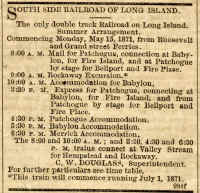 |
South Side
Railroad of Long Island Schedule Effective: 05/15/1871 Archive: Art Huneke |
When the South Side began running express trains on the main line beginning in 1869, it unwittingly ran into difficulties. The crack train left Bushwick and made no further stops until reaching Merrick, Mr. Fox's own town, after which it made all stops to Patchogue. This non-stop run of twenty-three miles outraged the citizens of Jamaica who took mortal offense at the affront. The local journals commented acidly on the road's indifference to accommodation and spitefully commented on the danger to life and limb from expresses hurtling through the village at thirty miles per hour. The rival Long Island RR, hitherto reviled and scorned by the press, suddenly found itself basking in the sun of editorial favor.
In 1870-71 the South Side made efforts to speed up the service, especially the expresses. The double track, laid with sixty-pound rail, was a step in this direction and so was the purchase of the newest and fastest locomotive available. The advertised express speed was thirty miles per hour but this could be exceeded on occasion. In September 1870 a new South Side engine, the "Massapequa," drawing two cars bearing President Fox and several of the directors, made a speed run between Amityville and Babylon, a distance of six miles in five minutes. This new record of seventy miles per hour was the fastest known on Long Island up to that time.
One feature of the South Side operation would strike us today as being rather curious: there were no trains on Sunday. President Fox was a practicing Baptist, and most of the directors were eastern Long Island men reared in the strict tradition of Sabbath observance. The people of Brooklyn were not in accord with this uncompromising Sabbatarianism, and regarded the absence of Sunday trains as a hypocritical device on the part of wealthy Rockaway property owners to keep the beach on Sunday to themselves. Fox and his directors regarded the prosperity of the road as the visible proof of divine approval of his policy and resisted all attempts to inaugurate Sunday service. Certainly, it was noteworthy that the South Side RR remained conspicuously free of major accidents. True, there were individuals, both employees and juveniles, who met their deaths through taking reckless chances, but the road had escaped those spectacular disasters, the grisly accounts of which filled the press of the day.
A few minor accidents reach our ears:
- May 4, 1869: by error an engine was dispatched from the
Williamsburgh office over the track which belonged to an express
then nearly due. The engine plowed into the express train near
Bushwick doing some damage to the two engines, but none to the
passengers.
- August, 1871: The Babylon accommodation train was thrown from the track at Newtown Switch by a misplaced switch. The locomotive and three cars narrowly escaped falling down a steep embankment. No one was hurt, but travel was interrupted for about five hours.
- August 26, 1871: About 8:30 A.M. as the Fire Island Express was approaching Freeport from Merrick, it struck a broken rail which threw the three rear cars from the track down a five-foot embankment, leaving one overturned. Several persons were injured by broken glass.
- November 15, 1871: The Merrick accommodation train coming out of Bushwick struck a Metropolitan Avenue horse car which had derailed on the crossing. When the crew and passengers failed to rerail it in time, they left and the locomotive struck the stalled car, smashing it to pieces. No one was hurt.
- January 27, 1871: Two passenger trains were scheduled to pass each other at Jamaica. The eastbound one lay waiting at the siding. The westbound train, as it approached, split the switch, derailed, and sideswiped the cylinder head of the standing engine. Both engines were damaged but no one was hurt.
July 4, 1872: A train pulled by the Charles Fox left Bushwick Station later than it should have in order to reach the double track at Newtown Switch on time. Meanwhile a westbound excursion train of six cars from Rockaway, drawn by the engine R. O. Colt, left the double track at Newtown Switch and entered on the single track for Bushwick. Hardly had the engine and two of the six cars moved onto the single line when the Fox loomed up. Neither engine could stop despite flags and whistle blasts and a collision occurred. Since the Fox was making about twenty-eight miles per hour on the steep upgrade at that point, no serious damage occurred. However, three coaches on the Rockaway train had their platforms telescoped by the impact, and three persons who were standing outside, lost their lives by being crushed in the splintered wood. This was the first passenger fatality in the history of the road. - August, 1871: The Babylon accommodation train was thrown from the track at Newtown Switch by a misplaced switch. The locomotive and three cars narrowly escaped falling down a steep embankment. No one was hurt, but travel was interrupted for about five hours.
Soon after the road was opened, it became obvious very quickly that the dispatching of trains would be difficult if not impossible without a telegraph system in operation all along the line. In February 1868, therefore, the directors of the South Side RR Co. organized a subsidiary called the South Side Telegraph Co., allocated $2000 to the project, and floated a new issue of stock to finance the cost of construction between Bushwick and Babylon. Construction of the new telegraph line was begun almost immediately (February 1868) and the company was shortly reorganized as the L.I. Telegraph Co. in order to build branches to any other communities where the inhabitants would subsidize the cost of extension.
As early as the second week of February 1868 the poles began going up along the railroad tracks. The system was scheduled to be completed and in working order by March 23. On April 1, 1868 the line was completed between Rockville Centre and Babylon and the first message sent over the wires that day. Meanwhile the line crew was busily working its way westward to Williamsburgh. The people of Hempstead began collecting a subscription of money to defray the cost of building a branch of the telegraph from Valley Stream to that village in January and completed it by mid-May. In August a branch telegraph line was extended down the Rockaway Branch from Valley Stream to Far Rockaway.
A year later in September 1869 the South Side RR went through the legal process of formally merging the Long Island Telegraph Co. into its own corporate structure. Preparations were made at the same time to build the final segment between Babylon and Patchogue. The last we hear of the telegraph system is a cryptic note of April 1870 stating that the South Side RR bought in the L.I. Telegraph Co. at foreclosure sale. Lacking more definite information, we must assume that this was simply a legal maneuver by the railroad to secure possession of the wires without the encumbrances of bond and stock obligations to pay off, such obligations being usually wiped out in a foreclosure proceeding.
Closely allied with the telegraph service was the handling and dispatching of the United States mails. Previous to the coming of the South Side RR, the Long Island RR enjoyed a monopoly of the government contracts for transporting the mails on Long Island. When the South Side opened in 1867, it was to be expected that mail for the south side villages would fall to the new company. Somewhat surprisingly, this proved to be a slow process. The transfer appears to have been done piece-meal at first, at certain stations and not at others. For example, the mail at Amityville was changed over from the Long Island~ RR to the South Side on August 10, 1868. Not till July 1, 1869, however, was the mail for all the south side villages handed over to the South Side RR. Perhaps Oliver Charlick's potent political influence was effective in delaying the loss of the profitable mail contracts on his road.
In February 1870 the Postmaster-General further improved the speed of delivery of letters on Long Island by inaugurating a new mail route between Medford station on the Long Island RR and Patchogue on the South Side. Previously, all mail for the south shore villages originating at Long Island RR stations had been sent into New York and then transferred to the South Side. With the new service mail was transferred in mid-island the same day and delivered that much faster. Whatever further arrangements may have existed are not known today because of the paucity of our information.
The rolling stock of the South Side RR is rather well-known thanks to many scattered notices in the press of the day and the road's own reports to the State Engineer. In terms of mere numbers, this is the South Side's equipment broken down into types:
| Year | Engines | Passenger | Baggage | Freight |
| Coaches | ||||
| 1868 | 8 | 17 | 3 | 41 |
| 1869 | 11 | 21 | 5 | 75 |
| 1870 | 17 | 31 | 7 | 89 |
| 1871 | 18 | 35 | 7 | 89 |
| 1872 | 19 | 35 | 7 | 114 |
| 1873 | 20 | 50 | 5 | 117 |
Nearly all the South Side Railroad's locomotives were of the typical American 4-4-0 type. In 1867 only one engine, the Charles Fox was operating; in 1868 the Daniel T. Willets, the Alex McCue, the R. O. Colt, the John Tappan and the J. B. Johnston arrived, all named after the officers of the road. In 1869 two more were purchased, the Fire Fly and the Pewit. The year 1870 marked a great increase in equipment purchases for in this year were bought the A. J. Bergen, the F. B. Baldwin, the A. McLean, the South Side, the Springfield, the Massapequa, the Merrick and the Norwood. The final purchases, made in 1872-73, were the Islip, Patchogue and the Norwood.
It is easy to discern two different naming patterns in use: the first eleven honored the company's president and officers; the Pewit forms an exception, coming from the Central RR of NJ; the Fire Fly appears to be a fanciful name: all the remaining eight engines derive their names from Long Island localities.
We are in a much poorer position regarding the background of the passenger coaches. The builder and the date of construction alike of the first thirty-five coaches have not come down to us; we do know the last fifteen coaches were turned out by the New Haven Car Co. From pictures we know that the coaches resembled the typical railroad cars of the Sixties-all wood with a flat raised roof, slightly rounded over the platforms, thirteen to fifteen windows to a side and lighted with gas lamps. Combination baggage and express cars had three doors cut irregularly into the sides.
As for the dummies in use on Boerum Street and Broadway, Brooklyn, our information is meagre. The first dummy, the City of Brooklyn was placed in service on July 31, 1869. Later three others were added in 1870, but we know the name of only one, the City of Breslau.
Several personalities who were important in making the South Side RR of Long Island a success bear mentioning. Charles Fox was a New Yorker associated with F. B. Baldwin, an alderman for several years and an active man in real estate both in New York and on Long Island. Baldwin appears to have started the present village named after him and induced Fox to make other large investments in Baldwin and Merrick. Fox owned so much of the land there that the street names of today--Foxhurst Road, Fox Avenue--still preserve his memory. He was a devout Baptist and not only opposed running trains on Sunday while he was president but also was a strong temperance man. An order issued by him in May 1870 was posted in all crew quarters of the South Side RR: "The use of intoxicating liquors, profane or obscene language, or smoking by the employees of the South Side RR of L.I., while on duty, is strictly forbidden." In January 1873 Fox sold out all his interests in the SSRR and devoted himself to building apartment houses in New York. He died on September 20, 1879 as a result of the internal injuries he received in the station platform accident of 1867. He was sixty-three at the time of his death.
Willet Charlick of Freeport, one of the most active promoters of the road, lived just long enough to see it completed. On July 16, 1869 he suffered a heart attack in New York and died. His brother, Oliver Charlick, forgave him sufficiently to personally escort the remains from New York to Hempstead in the Director's Car.
The Willow Tree Disaster of April 23, 1869 on the Long Island RR killed two other men associated with the South Side RR, Thomas C. Shanahan, the contractor who built the road, and William C. Rushmore, the treasurer. The latter's death was particularly embarrassing because many shortages turned up in his accounts after his death.
The superintendents of the road seem to have all been capable men. The first man was Robert White, ex-superintendent of the Long Island RR and himself a railroad contractor. He resided at Merrick with President Fox and appears to have been genuinely popular on the road. We read that at Christmas of 1868 the employees gave him a tree loaded with presents and White responded with a supper party thereafter. In October 1869 White left his post and acted as contractor for the New York & Hempstead road between Valley Stream and Hempstead. Charles W. Douglas of 56 Driggs Ave., Brooklyn, an engineer and a man of large experience, was the next superintendent. After three years' service Douglass was replaced in September 1872 by Walter Homan, the former trackmaster of the road.
| SSRR Pass issued
for 1872, good until 12/31/1972 signed by Superintendent Charles W.
Douglas prior to 09/1972 Archive: Art Huneke
|
Curiously, only one humble conductor on the South Side is ever mentioned in the press, one Robert Cochran, but he turns up often and always with favorable comment. He joined the road in 1867 and was cited often for his sunny disposition and genial manner. Later he retired and opened a bar at the Broadway Ferry. Considering the rarity of genial conductors in any age, it seems justifiable to honor this man's memory in these pages.
One final interesting detail remains to be chronicled--mention of some of the strange and curious extensions proposed but never built. In the summer of 1868 the residents of East New York and Woodhaven, dissatisfied with railroad accommodations then available, asked the South Side RR to build a branch along Cypress Avenue, Cypress Hills Street, Euclid Avenue, and Rockaway Boulevard to a point in Woodhaven. It would be interesting to know what President Fox thought of this fantastic proposal. A variation on this was proposed in March 1869 with the suggestion that the railroad build to the Ridgewood pumping station at Sunrise Highway and Atlantic Avenue and then straight south to Spring Creek. The coal delivered to the pumping station was supposed to support the line. The final proposal was one made by the residents of Queens Village who were dissatisfied with the LIRR. They sent committees to President Fox and engaged surveyors to map out a branch roughly paralleling Springfield Boulevard, but we hear nothing of it after 1871.
CHAPTER V: The Hempstead Branch: The Tangled Affairs of the New York & Hempstead
When the South Side RR successfully opened its line to Babylon in October 1867, there were many towns on Long Island that rejoiced to see the Long Island Railroad's monopoly on travel at last broken. Oliver Charlick, though a capable administrator and an able man in finance, was almost completely devoid of a sense of tact and finesse in handling people and as the years passed, few men on Long Island were more disliked or more pilloried in the press than he.
Hempstead, one of the largest villages along the line, had been served since 1839 by a shuttle train which carried passengers north to the main line at Mineola. Over a period of years the single coach had been drawn by horses and later a very small steam engine. Dissatisfied with these primitive accommodations, the residents of Hempstead resolved to secure for themselves an outlet to the much newer and more liberal South Side RR.
The first step was the legal one of incorporating the Hempstead and Rockaway Railroad, to run from Valley Stream to Hempstead. In April 1868 a campaign was started and $30,000 was raised to insure the connection; surveyors were put to work immediately to layout a route to Valley Stream. By June 1 a contract for building the branch was awarded to Vandewater Smith of Hempstead, the completion date being set at July 1. Because of financial difficulties the work soon came to a standstill and the Long Island RR increased the difficulties by securing an injunction on August 29 enjoining Smith's crew from crossing a portion of their terminal property at Hempstead.
A whole year passed by without action of any kind; then, in September 1869, several public meetings were again held to revive the project, and a renewed effort was made to raise money through stock sales. In the first week of January 1870 it was reported that the stock was being rapidly marketed. So well was the money coming in that ground was broken for the new branch on January 22, 1870 despite the frost and ice of winter.
In March the backers of the new project appear to have gone far beyond the idea of building a mere branch line to Valley Stream, for they incorporated themselves at Albany under the pretentious title of the New York & Hempstead Plains R.R. and mapped a route from Hempstead through Valley Stream, thence south of Jamaica through Flatbush and New Utrecht to a point on the East River at Sixty-fifth Street, Bay Ridge. It was hoped to complete the road to Valley Stream over the summer of 1870 and the remainder the following year. Grading for the line began on March 21, 1870.
In April 1870 the contract for building the new railroad was again awarded to Vandewater Smith, who made arrangements with Robert White to do the actual physical work. On April 26 ground was broken and the target date was again set for July 1. The Hempstead Brass Band turned out and put on a grand street concert on the evening that the contract was signed. All during July the work moved on briskly and in August "two new and beautiful coaches" were secured and one tank saddle engine from the Grant Locomotive works, named the William L. Wood. Both were stored in the South Side Railroad's engine house at Jamaica.
By September 1, 1870 the grading and the laying of the rails through what is now Malverne and Lakeview was progressing satisfactorily. On August 31, 1870 a special excursion train, consisting of friends and guests of the road, ran over the finished portion of the railroad. The grading had been completed the entire distance and the track was laid to within a mile and a quarter of Hempstead. Everyone was well pleased and complimented Mr. Smith on his work. On September 12, 1870 the first train ran all the way through to Hempstead village and for two weeks thereafter occasional trains operated back and forth. On September 28, 1870 the road was publicly opened and trains ran on a regular schedule for the first time.
Operation was entrusted to the South Side RR Co. who were to operate the line as their Hempstead Branch pending the completion of the rest of the road to Bay Ridge. The fare was set at 50¢ a trip to Brooklyn or New York or $75 a year. The new road left the South Side Valley Stream station at Fifth Street and struck out northeastward. It crossed Franklin Avenue, Malverne, close to the present little stream between Wheeler Avenue and Cornwell Avenue; here was situated the little hamlet and station of Bridgeport. The track then paralleled Cornwell Avenue exactly, crossing Hempstead Avenue, where was located the tiny settlement and station of Norwood. The Pine Brook was crossed on a little bridge only a foot or two above water level. At Woodfield Avenue and Oak Place was Woodfield depot. Immediately to the east the track crossed the Schodack Brook on an embankment and culvert about five or six feet above the stream bed. As the track approached Hempstead village, it crossed the Horse Brook or Rockaway Brook on a small bridge and then paralleled the brook a few blocks, terminating at a little station on the west side of Greenwich Street midway between Front Street and Prospect Street. Here there was a short stretch of double track but no turntable. Service was maintained with about six trains a day in each direction.
The local residents of both Hempstead and Valley Stream turned out en masse to ride the new facility, reaching a peak of 1028 in one day. The company hoped to build a handsome depot in Hempstead and covered platforms as soon as practicable. By mid-November the ticket office and waiting room were fitted up and most of the travel to New York patronized the new road in preference to the Long Island RR.
With the Valley Stream-Hempstead link completed and in operation, the New York & Hempstead Plains RR turned its attention to the west end of its route. In August the N. J. Bergen farm at Sixty-fifth Street, Bay Ridge, with a waterfront of 800 feet had been secured. The directors also voted to alter slightly northward the projected route, so as to pass through East New York, Woodhaven and Springfield. At least part of the reason for this was the urging of several committees of East New York civic officials who hoped the new road would help boom the town. In Woodhaven some of the right of way was donated, and Florian Grosjean, president of the Lalance and Grosjean Agate Works, the biggest industry in Woodhaven, offered to give any other land needed. Broadway, the present 101st Avenue, was considered the ideal east-west route for the company to take through Woodhaven to Jamaica. At Bay Ridge it was pointed out that the company's docks faced the great coal depot at Elizabeth, New Jersey, and that the company could develop a vast business in ferrying loaded freight cars across the bay and directly onto Long Island without breaking bulk.
In the effort of construction and land acquisition the company must have over-extended itself, for, pressed by creditors, the road was foreclosed and sold at sheriff's sale to Electus B. Litchfield, the developer of Valley Stream on December 17, 1870. Just the day before, the lone engine and two cars had been seized and attached for debt by creditors. The trouble was not caused by any fault on the part of the company but by the shortcomings of the contractors who were for the time being running the road. As a by-product of the reorganization of the road the two original companies were merged on July 7, 1871 to form the New York and Hempstead Railroad. The new organization contained some powerful and wealthy men and completion of the road seemed assured.
The brief trouble was not permitted to disrupt the ambitious plans of the promoters. In December 1870 surveyors mapped out a continuation of the line eastward from Hempstead across the Hempstead Plains to Breslau. In February 1871 another change of route was made on the western end of the railroad, the track being now scheduled to pass through Jamaica and terminate in Garden City. In East New York several farmers donated a right of way to the railroad, and by March the contract was let for grading and constructing the road to one Patrick Shields of Jamaica who immediately put a large force to work at three points, Flatbush, New Lots and Woodhaven. By mid-June the grading gangs had progressed as far as Woodhaven Boulevard and by mid-August to Dunton.
In the midst of all this negotiating the directors of the road were startled to receive word that their one and only locomotive, the W. L. Wood, had blown up in Hempstead station on July 18, 1871. Investigation disclosed that the boiler had burst, scattering fragments in all directions. The afternoon train was just about to start when the explosion took place. The engine was immediately brought to Brooklyn for repairs which were expected to cost about $3000, and in the meantime such South Side engines as could be spared gave service on the branch.
The financial and administrative condition of the road meanwhile was getting more complicated daily. A Mr. Pusey, the agent who had furnished the iron to build the road, had taken in payment the company's notes, and some of the bonds to the extent of $46,000, double the amount of the notes, as collateral security. When the notes became due, the company paid a small portion and by way of settlement, Pusey promised to do certain things for the railroad, provided he became the next president. The company agreed to elect him, but it was soon discovered that his promises were not only not being fulfilled, but that he was secretly plotting to secure possession of the whole road. The directors then unseated him and elected another in his place.
Pusey, in anger, had the bonds sold and bought them in himself at 25¢ on the dollar. As this paid only half of what was due him, he commenced an action for foreclosure against the company. The directors offered to pay Pusey all the debt with interest, if he would surrender the bonds lodged with him as collateral. Pusey refused and demanded $5000 as a bonus for such action. This the directors declined to pay and served an injunction on him restraining him from pressing his foreclosure suit. The contest then remained deadlocked for seven months (June 1871-December 1871).
Late in December 1871, the court which had sat on the injunction dispute, gave a verdict dissolving the injunction. The Brooklyn Trust Co., holders of the mortgage bonds, appointed on its own a receiver without seeking a court order, or even more surprising, notifying the railroad. The receiver appointed was Seaman Snediker of Hempstead, the road's first president, who immediately made arrangements to take over and notified the one and only train crew to take orders from him. The conductor at first agreed, but later made his returns as usual to Mr. Goetchius, the treasurer of the road.
On the evening of January 8, 1872 Mr. Snediker and Mr. Pusey went to Hempstead and seized the road as agents of the trust company on the advice of the bank's counsel. As the last train came into Hempstead that night, Snediker and Pusey impounded it and had the conductor arrested for embezzlement. The hapless conductor was arraigned in court and agreed to hand over three days' receipts to Snediker as agent of the bank.
Late that night, Snediker and Pusey went to sleep in one of the two coaches. Very early the next morning, E. B. Litchfield, representing the owners, and Mr. Goetchius, the treasurer, arrived in Hempstead and found Snediker and Pusey and a constable with a few hired men asleep in their car. Mettler, the lone engineer, was on his engine, readying it. Very quietly Litchfield and Goetchius, with some employees loyal to them, detached the engine and proceeded with it some distance down the tracks so that it could not be secured. The noise awakened Snediker and Pusey, who rushed out and threw sticks and stumps on the track to stop the engine but in vain. Pusey ordered Mettler to return and attach his engine to the coach but instead of doing so, he ran up and down the tracks several times and refused to heed Pusey's orders.
Litchfield then advised Mettler to back into the station to pick up the passengers for the first trip out; the usual number were waiting and wondering what was going on. As the engine approached the platform, Pusey suddenly produced a pistol and fired two shots, one of which dented the dome in front of the engineer. Pusey was excited and claimed that he was aiming at the engine and not the crew. The passengers were upset by the unexpected gunplay and the cry arose to lynch Pusey. Calmer heads cooled the fight and the dispute was settled by the passengers who brought the train to Valley Stream themselves.
Pusey stayed behind and returned on a later train to New York but a warrant was issued for his arrest and a constable took the next train in pursuit. Things had reached such a point of confusion that a conference was arranged of all interested parties. The trust company was taken to task for appointing a receiver without court approval; when Snediker realized his false position, he turned over moneys and tickets in his possession to Goetchius, the treasurer. This ended the "war" and trains again ran peacefully and regularly.
In February 1872 Electus B. Litchfield resigned the strenuous presidency of the road and was succeeded by Henry M. Onderdonk, editor of the Hempstead Inquirer. Onderdonk was succeeded in turn by Abraham Wakeman in September 1872.
In the spring of 1872 the contractor for the west end of the road, Mr. Louis Broad, died, and for some months thereafter work was suspended. On August 15, 1872 work was again resumed on the Bay Ridge end, and on the eastern extremity of the road surveyors Cornelius and Seaman completed the line of the road from Jerusalem School House (presently the junction of Wantagh Avenue and the Southern State Parkway) to the Hempstead depot. As winter closed in mid-November the contract for the west end was re-awarded to Walker, Fairchild & Clarke, and the east end to Shields & Rattin.
Nothing could be done over the winter months but with the end of March, the whole project sprang to life and fresh details were released to the press. The estimated cost of the road from Bay Ridge to Valley Stream was $600,000 including right of way and dockage. The Bay Ridge dock was to be 850 feet long, extending into the water 500 feet on one side and 800 feet on the other, with a minimum depth of water of fifteen feet. The Bergen farm of seven acres provided abundant land for freight and passenger facilities. A short distance inland was the most expensive grading on the whole road, one item being a tunnel 1780 feet long with an opening 24 x I6½ feet from the ridge to Sixth Avenue. Beyond that point and for the next five miles, the road was planned to pass under the major Brooklyn highways midway between Sixty-fifth and Sixty-sixth Streets.
The deepest cut was forty-three feet at the Ridge itself; the average for a mile or so being about thirty feet with a width of thirty-two feet. Most of the sand and gravel being removed was used to fill in the hollows and bring up to grade Sixty-fifth and Sixty-sixth Streets. From Fifth Avenue to the shore there were in June 1873 a force of about ninety men with forty horses and carts. The cut passed right through the old apple orchard of the Bergen farm, and the old mansion commanding a fine view of the bay degenerated into a bunkhouse for the shelter of the workmen. Between the shore and Third Avenue ties had already been laid on the graded area and all was in readiness for the iron. All New Utrecht seemed to be booming as a result of the influx of men and machinery and optimists fondly looked forward to broad vistas of new streets and suburbs in every direction. The entire project reminds us startlingly of the present-day Bay Ridge Division of the Long Island Railroad, built only a short time afterward and to a very similar pattern, and utilizing this same roadbed.
At Bay Ridge a dock crib and dredging machine were anchored and set to work to dig out the required depth, while at Hempstead the contractor was building an embankment across the low lands between Greenwich and Henry Streets, and further grading was being done through the east end of the village towards Uniondale.
Great things were hoped from the new road. A large backward area of Kings County and an empty area south of Jamaica were to be developed and opened to commerce and settlement. The Bay Ridge docks were so favorably situated with reference to the Jersey Central and Lackawanna docks that the lion's share of bulk freight would pass over the new road. In March 1873 the directors of the road opened conversations with Oliver Charlick for permission to use the Long Island RR rails between East New York and Dunton, and with President Fox of the South Side for the use of the tracks between Dunton and Valley Stream.
| SSRR Savings Bank
Check 8/11/1873
|
To the surprise of all, the New York & Hempstead Plains RR in June 1873 announced that it had leased its entire road and project to the South Side RR for a period of 999 years. The New York & Hempstead was to retain its identity as a separate organization for a while yet, but once the Bay Ridge project was completed, it was likely to be merged in the South Side organization.
In the fall of 1873 when the New York & Hempstead project was at its peak and as certain of completion as any other commercial venture in the city, a completely unforeseen disaster struck a mortal blow to the whole project. In October 1873 a financial panic struck the market, and within a week the banking house of Jacob R. Shipherd & Co., owners of the South Side RR, collapsed in the general ruin. All work on the New York & Hempstead RR came to a halt, and the grandiose project of a great new system collapsed never to be revived. The short stretch of road that had been operating between Hempstead and Valley Stream, instead of being a major portion of a new railroad network, sank to the status of an unimportant branch, and its subsequent history dependent on the changing fortunes of the South Side RR.
CHAPTER VI: The South Side Falls to the Long Island
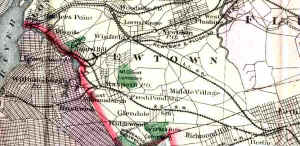 South Side
Rail Road Colton Map, Western Terminus 1873 South Side
Rail Road Colton Map, Western Terminus 1873Archive: Art Huneke 187
|
New Year's Day of 1873 had passed but a short time when the traveling public was startled to learn from the newspapers that President Fox and his Board of Directors had sold out their interest in the South Side RR to the Boston banking firm of Jacob R. Shipherd & Co. of 24 Pine Street, New York. It was reported that the negotiations were consummated only when it was agreed at a meeting of the principal shareholders for each to sell a bare majority of his interest and retain the rest. Thus, not a single owner would be bought out, and the corporation would retain as large a group of the same individual stockholders as before.
The actual transfer of control took place on January 21, 1873, and, as a result, several of the important posts in the management of the company changed hands. Jacob Shipherd himself became president of the road, and a Mr. L. S. Canfield from the Warren & Franklin RR of Pennsylvania became superintendent.
It is an old saying that a new broom sweeps clean, and the new management was determined to let the employees and the public know that they proposed to infuse renewed energy and vim into the road. For example, on the morning of January 28 Mr. Canfield personally ran a train from Hempstead over the branch and main line to South Eighth Street in the record time of forty-eight minutes to the great pleasure of the commuters who usually made the run in an hour and twenty minutes.
To further impress the travelling public, and attract riders, Canfield made a fetish of running trains exactly on time all through the snows and heavy weather of January 1873. He gave Hempstead an express service and put on night trains to ingratiate himself with travellers. There was excellent reason to do this. The South Side RR originally had only the Long Island RR for a competitor and this competition was limited largely to Jamaica. With the opening of the Hempstead Branch, there was renewed rivalry for the traffic of Hempstead. Then in 1873 the competition became still keener, for, in August, Alexander T. Stewart, the merchant prince who founded Garden City, opened his Central Railroad of Long Island from Flushing through Floral Park and Hempstead eastward to Farmingdale and Babylon, and with a short branch to Hempstead. That meant that the South Side's monopoly of travel through the south shore villages was broken, and that all three roads competed fiercely for the business of Hempstead. The anxious concern of the South Side RR, therefore, to make travel as attractive as possible was not altogether an act of altruism; to a degree it was dictated by the need to survive. The company even made plans to extend the double track at once from Valley Stream to Babylon and contracted for the iron; four more engines were ordered (and later delivered) and overtures were made to Oliver Charlick for the purchase of the Sag Harbor Branch of the Long Island RR to lay the groundwork for a through road all along the south shore.
The spring and summer of 1873 passed pleasantly enough; the railroad held its own fairly well in the face of competition with its two rivals. Then in September a disaster occurred that was to change completely the subsequent history of the road. On September 18 the great banking house of Jay Cooke & Co. closed its doors in New York, Philadelphia and Washington. Cooke's fame had begun during the Civil War with his successful flotation of the bond issues by which the North financed its operations. After the war he turned his attention to railway securities, and in attempting to back the Northern Pacific RR, he met disaster. The huge sums needed for this undertaking could not be obtained without European assistance, and after the Franco-Prussian War of 1870, foreign capital became harder and harder to get. Cooke tied up so much of his firm's resources in advances to the railroad that his partners finally took the drastic step of closing. Cooke's company was regarded as the last word in solvency, and when its closing was announced, the Exchange was immediately thrown into a wild panic. Two days later, the Exchange itself was closed and so remained for ten days. A run on the banks occurred, and industrial concerns, dependent on banks, failed by the score. Bankruptcies followed thick and fast and business came to a standstill.
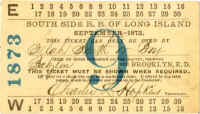 |
South Side
Railroad Pass 09/1873 Archive: Art Huneke |
Among the lesser banking houses involved in the general ruin was Jacob R. Shipherd & Co., the new owners of the South Side RR. Only a month later--November 1873--the trustees of the third mortgage bonds demanded that the road be placed in receivership. The directors, after vain consultation, agreed to surrender the road. Over the winter months a number of suits were instituted against the South Side RR by the holders of the first and second mortgage bonds when the interest coupons were not redeemed.
In the spring of 1874 a long wrangle broke out between the State and Federal courts as to jurisdiction. Each side appointed a different set of officials to look after the running of the road, and there were absurd incidents of appointees barricading themselves in the company's various offices and converting the premises into a fort against the opposing party, seizure of books, suits and countersuits to repossess them, smashed padlocks, etc.
On September 16, 1874 the property of the road was put up at public auction. As the bidding progressed, it became evident that the Flushing, North Side and Central RR was interested in acquiring the property. Finally, Elizur B. Hinsdale, agent for A. T. Stewart and the Poppenhusens who owned the Flushing railroad, bid in the South Side properties for $200,000. The road's liabilities totaled $2,554,225 and its creditors included not only the various bondholders but also the contractors Walker, Fairchild & Clark, who did the work at Bay Ridge, the U. S. Rolling Stock Co. for lease of engines and cars, and the Schenectady Locomotive Works, who built the last three locomotives purchased.
The fact that there were no less than four important mortgages on the road made the financial arrangements unusually complicated. In June 1867 a first mortgage of $750,000 had been made by the South Side RR in favor of D. R. Floyd-Jones and Treadwell Ketcham as trustees. In September 17 another mortgage, this time for $2,250,000, was placed on the road to secure funds for construction and equipment. In August 1871 the third mortgage of $500,000 was made out in the name of Nicholas Wyckoff and Elbert Floyd-Jones. The yield from this mortgage financed the laying of the double track. The fourth mortgage in the amount of $60,000 was assumed by the South Side RR from its subsidiary, the Far Rockaway Branch RR, and had been executed in favor of Daniel D. Lord and John H. Cheever both Far Rockaway capitalists. It is easy to see that complicated court settlements and much litigation were required to satisfy the conflicting claims of all four mortgages, plus the unsecured claims of creditors.
As soon as the new purchasers took possession of the South Side road, they made immediate efforts to maintain the high level of service under the Shipherds. Isaac Barton, ex-superintendent of the Long Island RR and superintendent of the united Flushing North Side & Central railroads, now assumed the same post on the South Side RR. The Poppenhusens on September 25, 1874 transferred their purchase to a new organization of their own creation and changed the old name of the company to "The Southern Railroad Company of Long Island." The new owners resolved on a few other changes as well, namely, raising the station platforms to eliminate the car steps and installing a physical connection between the Southern and Central roads at Babylon (Belmont Junction). It was rumored at this time that the Poppenhusens would soon scrap the expensive dummy operation in Williamsburgh.
A month after the South Side RR changed hands, trouble broke out again on the little Hempstead Branch. In September 1874 the Lackawanna RR made overtures to secure the property and franchises of the New York & Hempstead RR in the hope of consummating the master plan of making Bay Ridge the great central coal depot whence Long Island and Manhattan might be supplied. The investment proved excessively costly and the plan was allowed to die.
In October the Brooklyn Trust Co. foreclosed its mortgage on the New York & Hempstead RR. At least part of the reason for this was the loss of patronage on the branch because of the competition of the Long Island RR and the Central RR which entered Hempstead in January 1873. There was simply not enough business in town to support three roads. When the manager for the South Side RR heard of the bank's motion, he ordered his trains to stop furnishing service as of October 27, 1874. The New York & Hempstead was then advertised for auction on October 28.
On the night of the twenty-sixth, just before the service was scheduled to be cut off, someone with an interest in the road, fearing that the engine and cars would be confiscated and sold, sneaked into the Hempstead depot, tore up the tracks and switches, ran the engine and cars off the track, and completely looted the freight house and ticket office of their contents.
On the morning of October 31 a Brooklyn judge granted an order canceling all the bonds of the Hempstead & Rockaway RR. Robert White, who had gotten the contract to build the road for $100,000, had thus far received only $5000 and he now began an action to recover the balance. He traced $80,000 of stolen bonds to Vandewater Smith, the agent who had gotten him the contract and notified the court. Judgment was ordered for the transfer of $80,000 worth of bonds to White and $4000 damages in addition. Meanwhile at the auction sale of the road on October 29, 1874 the whole was knocked down to the Brooklyn Trust Co., trustees of the bonds, for the benefit of the stockholders. These gentlemen expected to make a satisfactory disposition of their property as soon as the referee determined the validity of the disputed bonds.
About November 1 the road was reopened to traffic, the trust company making arrangements with the Southern RR to furnish the equipment and crews. The old engine, equipped with a new boiler after the explosion of 1871, was still in service but the two coaches had been repainted and transferred to the Central RR.
Hardly four months later the Hempstead Branch again made news. The week of January 31, 1875 opened dark and stormy over Long Island; wind-driven rain pounded down intermittently and swelled what were normally small rivulets into swollen streams. On the line of the New York & Hempstead RR there were two such crossings, the Pine Brook at Norwood and Schodack Brook just east of Woodfield depot. The latter stream rose only a short distance north of the tracks; one fifteen inch pipe carried the water under the track; the embankment here was about nine feet high and the rainfall had backed against it a lake a few feet deep.
On Wednesday evening, February 3, 1875, after the last scheduled train had pulled into Hempstead, the crew, instead of laying over, decided to go back to Valley Stream slowly to check on the storm damage which had been getting worse all day. Accordingly, a party of seven, consisting of the engineer, conductor, trackmaster, assistant superintendent, fireman and trackman started their tour of inspection. The train, consisting of the W. L. Wood and one car left the flooded Hempstead depot at 8 P.M.
Near Woodfield station the trainmen approached Schodack Brook and observed the large lake against the railroad embankment. The trains, which were running backward for lack of a turntable at Hempstead, moved over the brook slowly. The light coach passed over the spot, but the engine suddenly collapsed through the roadbed and tumbled into the water below, dragging the coach with it. The boiler on the engine exploded with a roar, tearing a hole in the embankment and blowing the car to pieces. Four of the crew were killed almost at once, and three injured.
The subsequent investigation disclosed that the dirt under the track had been washed away sufficiently to fit a barrel into the space. Evidently the frozen earth held up the track sufficiently to permit the light coach to pass safely, but the heavier engine broke through. It is interesting to note in passing that the Woodfield disaster is the oldest railroad wreck on Long Island of which an actual photograph survives.
The accident shut down the Hempstead Branch altogether, there being no other rolling stock. In June the court opened hearings on the bond dispute between Smith and White, and when White was called to the stand, some interesting testimony was elicited. White testified that he had received only $5000 of the $100,000 promised to him to build the branch. He alleged that Vandewater Smith borrowed the bond book of the company at the time the road was completed in September 1870, took it to New York, and when the book was returned to him, $80,000 in bonds had been cut out. They were soon heard of in Wall Street and White found out upon investigation that the bonds had been pledged with a well-known banker. To protect himself, White then had taken the engine off the road, whereupon the directors arrested him for stealing the locomotive, but he was discharged. Subsequently, he commenced an action to recover the bonds, the result of which was in his favor. It was then that the Brooklyn Trust Co. had given a loan on the road, and shortly afterwards, it fell into the hands of the South Side RR to operate. White, rather than pay storage for his engine and cars, allowed them to use the equipment. The South Side purchased the engine soon afterwards, but lost it in the Woodfield disaster. The two passenger coaches, which White originally purchased for $10,000 were exempted from the assignee's sale, but were included in the sale of the trust company. When the Poppenhusens assumed control of the South Side in November 1874, they took the cars, repainted them and transferred them to their Central Railroad of Long Island.
White, in retaliation, placed men at work to fence in the Hempstead-Valley Stream right-of-way, for every foot of which he had deeds in his name. A compromise between the Poppenhusens, new owners of the South Side RR, and White was reached in June 1875. The former purchased the disputed road, and proposed to open it immediately. On June 28, 1875 trains of the Southern RR began service on the old New York & Hempstead.
Only five months later another major wreck drew newspaper attention to the Southern RR and its operations. On July 4, 1875 a train consisting of the engine Montauk, a tender, a baggage car, smoking car and passenger car left the Neptune House at Rockaway and at 1:40 P.M. reached Far Rockaway and took the siding there. Meanwhile, a train of seven cars drawn by the engine Norwood left Bushwick at 12:30 P.M. and by the time it reached Valley Stream, was running ten minutes late. When the train came to the turnout between Valley Stream and Woodsburgh, the engineer and conductor decided not to wait in the hope of passing the up train at Far Rockaway station turnout.
The crew of the Montauk, meanwhile, waited the mandatory interval of ten minutes on the siding and the customary five minutes further for the variation in watches. Then it started out. It so happened that the switchman was absent that day, and the engine, after clearing the switch, had to send back the conductor to lock the switch. This cost about two minutes' delay, and then the engineer opened full throttle to make time up the ascending grade toward Lawrence.
Beyond Far Rockaway station the track began a long curve through Mott's Woods for about a half mile and then a straight stretch of a full mile. The Montauk had barely gone into the woods over 1000 feet when the Norwood was seen belching smoke dead ahead. Both engineers blew "down brakes" (one sharp blast) and jumped. The engines smashed into each other and when the dust settled, the tender of the Norwood was mounted on top of the Montauk, and the smoking coach and baggage car on the Bushwick train were telescoped twelve feet into each other. One or two other passenger cars were unbroken, but their platforms were crushed. Here occurred the worst loss of life. In all, nine persons were killed, the firemen of both trains and those standing outside on the platforms.
The inquest developed some interesting facts about conditions on the Southern RR. The Poppenhusens had removed the telegraph office at Woodsburgh in the course of lengthening the turnout there 100 feet. They had also done little or nothing on track maintenance on the Rockaway Branch. The rails had no "patent" connections (probably fish plates) but were joined by old-fashioned chair fastenings the spiking of which was often loose. A team of reporters walked the roadbed and reported that the rails were often worn and occasionally split, and that fully half the ties were rotten with only occasional good ones. The impression was given that everything of the best went to the Central RR of L.I. and that the Southern RR got what was left. The inquest verdict blamed the Lawrence wreck on the two conductors, both of whom were running on time not belonging to them. The railroad was censured for having only two brakemen on a seven-car train, for altering the time-table on a holiday, and for bad maintenance. Significantly, the railroad restored the Woodsburgh telegraph station within three weeks.
As proof of the rotten condition of the roadbed, another train on July 13, consisting of an engine and seven cars, was thrown on the sand by spreading rails at a point one mile west of Far Rockaway, and after bumping along on the ties, jogged to a stop. The locomotive plunged down a five foot embankment, the tender followed, and the baggage car, smashing past, sprawled across the rails at right angles to the line. No one was hurt and the coaches were undamaged, but it was another grim reminder that all was not well on the line. Much of the travel thereafter took to the rival Long Island RR, people shunning the Southern road as a death trap.
The Rockaway wreck had an unexpected side effect. The Southern RR, which had seriously contemplated pushing eastward from Patchogue toward Moriches, and had even begun moving material for that purpose, had to call off the whole project. Instead, the ties and iron were reshipped from Patchogue to Rockaway and three gangs of track layers were kept constantly busy repairing the dangerous roadbed.
An important feature of the rehabilitation project was the extension of the telegraph line from Far Rockaway station to the Neptune House terminus. The telegraph service was entirely reorganized and new and capable operators installed in the places of those found incompetent or inattentive. With the improvement of the telegraph, a new code of train signals was put into operation whereby the chief dispatcher at Bushwick might know the movements of any train anywhere on the road. More impressive still was the installation of vacuum brakes in place of the old hand brakes on all the Southern engines, coaches and freight cars.
As if to insure the impossibility of another costly wreck on the Rockaway Branch with its damaging publicity, elaborate and painstaking track repairs were again prosecuted the following spring (May 1876) just before the beginning of the beach season. A gang moved south from Valley Stream down the peninsula removing every unsound tie and covering the roadbed with a heavy loam about a foot deep with a layer of gravel at the top. By this means the shifting sand was held in place and kept from blowing out from under the ties. Steel rails were substituted for iron ones all along the Rockaway Branch and on the main line. The managers of the Southern were sparing no expense these days to bring back the former high reputation of the system.
During 1874 and 1875 another powerful movement was at work in Williamsburgh that would materially affect the operations and fortunes of the Southern RR. When the road first entered Williamsburgh in 1868, service from Bushwick Station to South Eighth Street ferry had been maintained by teams of horses drawing individual coaches to the ferry. Then, in 1869, the railroad, over powerful opposition, had mustered the bare minimum of support necessary to insure the introduction of dummies on Boerum Street and Broadway. To placate the opposition, the Southern road had three of the newest and best dummy engines available constructed for its use. To secure even further public support, the railroad at great expense promised to use the much less suitable groove rail for the standard T rail on its Williamsburgh track. Notwithstanding all these gestures of appeasement, the opponents of steam operation continued their agitation to drive the railroad from the streets.
One of the best arguments in their arsenal of weapons against the road was the toll of human life taken by the dummies. It was easy to pillory the railroad corporation as a souless monster ruthlessly monopolizing the public streets and crushing out the lives of golden-haired innocents under the wheels of its iron juggernauts. Such stories were charged with emotional potential and could be profitably exploited by politicians looking for an issue.
The facts were often quite different. The dummies, because of their low power and gearing ratio, could go no faster than eight miles per hour, and their bells and flagmen easily warned carriages and passers-by of their approach. Their very slowness, in fact, made them an irresistible attraction to boys of the neighborhood. Groups of lads often ran after the freights as soon as they pulled out of the ferry terminal, and grabbed the many handles and rungs on the cars for a free ride up Broadway and Boerum Street. The brakemen, busy at the front and rear of the train, were physically unable to watch each individual car and the boys could play on the platforms and in the interiors unmolested.
It was inevitable that eventually someone would be hurt. The first dummy City of Brooklyn began running on July 31, 1869 and three months later, on November 3, cut off the leg of a nine-year old boy who was playing in Boerum Street. The little fellow, George Smith, was attracted to the iron brace under the car, and in trying to catch it, missed his footing and fell across one rail, the car wheel passing over one leg. President Fox, though he felt no blame attached to the road, visited the needy parents and presented them with a purse of $50. Again on April 30, 1870 a child named Charles Fuchs, three years old, was playing near the track, and when the dummy stopped to let a wagon pass, grabbed the tension rod for a swing. The sudden starting of the dummy threw the child on the track and the wheels beheaded him.
The company was horrified when a third accident occurred within two months' time. On July 8, 1870 a twelve-year old boy named Louis Heim, who had sneaked a ride on a flat car, fell between cars when he decided to make a run from one to the other, and six wheels passed over his abdomen. The superintendent of the road, Mr. Douglass, admitted no culpability but freely offered to bear the expense of burial. At the inquest it was noted that it was the custom of numerous boys living at a distance from the ferries to steal a ride when on their way home, often loitering about the ferry a half hour or more for the train to leave the depot just to avoid walking home. When the cars started, the railroad police chased them at the ferry, but the boys soon caught the train along Broadway.
It is not known just what action the South Side RR took to avoid a repetition of these accidents, but it must have been very effective because we hear of no further casualties. Nevertheless, three such accidents provided grist for the mill of the anti-steam people. Indignation meetings were called and though poorly attended at first, continued to make themselves heard. The residents of South Eighth Street, which was only thirty feet wide and built as a residential street, continued their campaign to get rid of the dummies. No one seemed to mention the fact that the horse cars killed a far greater number of people every day in Brooklyn than did the South Side dummies.
To further placate public feeling, and to avoid the criticism made from time to time that their rails were breaking carriage axles and overturning wagons, the South Side RR, in August 1870, purchased heavy duty grooved rails for Boerum Street and Broadway. This was in accordance with a resolution of the Common Council of May 29, requiring grooved rails along Boerum Street. On September 16, 1870 these new rails were delivered; all were seventy-pound groove and would cover the whole distance to Bushwick depot. Installation of these new rails must have been started immediately, for by October 1 all the old T rail had been pulled up.
Oddly enough, in 1873 the South Side RR obtained permission from the Common Council to lay a modified strap rail along South Eighth Street and Broadway. The inner flange had to be built up with wood and to this would be spiked an iron strip half an inch thick, creating an iron inner flange and thus a virtual groove rail. Why this was done we are not told; perhaps the Broadway rails received heavier wear because of joint operation with the horse car companies.
Beginning with 1871 the campaign to get rid of the dummies gained momentum. In February of that year the residents requested the Common Council to repeal the permission granted to the railroad, alleging that the signatures on the petition circulated by the railroad for the right of using dummies were fraudulently obtained. The property owners complained further about the smoke and gases and potential danger to life and limb. A hearing was held on March 1 at which testimony generally favorable to the railroad company was voiced, and again on March 12.
The whole of the years 1872 and 1873 passed quietly without any agitation to expel the dummies. Then in 1874 trouble broke out once more. Apparently it was caused by the unwillingness of the South Side company to put down a whole new pavement after replacing all its rails to please the property owners. They sought relief from the State Legislature but the railroad bested them at Albany. They then sued the company in the name of one of the aggrieved property owners, who recovered a judgment of $ 1 500. It was appealed and the Court of Appeals confirmed the judgment of the lower court. Another suit for $500 was instituted with alike result. Inasmuch as the company had a mile and a half of track, there was a cheerful prospect of being mulcted of a million dollars. When the company went into bankruptcy in October 1874 the property owners considered it an evasion to end the suits.
Early in 1875 the embattled property owners of South Eighth Street and Boerum Street found a champion to redress their alleged wrongs, one Jacob Worth, an Assemblyman representing Williamsburgh at Albany. Worth, recognizing an issue when he saw one, and realizing this could be an important step on his political ladder, presented a bill in the Assembly for the abolition of the Eastern District dummies. The Brooklyn Eagle raised its powerful voice against the passage of the bill, insisting that the property owners of one street had no right to deprive a whole city of rail transportation and that the general welfare was paramount.
When the bill came up for hearing, the South Side RR argued that it had spent about $50,000 for four dummy engines, had built a large and handsome depot at South Eighth Street and would be subject to a loss of at least $100,000 by the change. Worth pressed his charge that the original petition was a fraud and that the property along the route had halved in value. He claimed that the travelling public could easily be accommodated in horse cars to the ferry. A resident testified that fifteen or sixteen heavy rumbling trains disturbed peoples' sleep, cracked walls, shook down ceilings, and loosened foundations.
On May 1, 1875 the bill was re-argued and ordered to a third reading. On the eleventh the amendment to postpone the abolition of the dummy till November 1, 1875 was accepted. When favorable passage of the Worth bill seemed assured, the South Side RR made preparations to pull out of downtown Williamsburgh. The freight depot was shut down immediately, probably in May, and negotiations were begun with the Bushwick RR Co. and the Broadway RR Co. to run their horse cars directly into covered platforms at the Bushwick depot to enable South Side passengers to continue their journey conveniently as was done at Grand Central Depot in New York. The railroad contemplated the enlargement of the Bushwick terminal, never too well equipped, by building a large new covered passenger station, additional freight houses, and administrative offices.
Beginning in February 1876 the Southern RR began physical preparations to run all freight and most passenger trains into their Hunter's Point terminal. Large gangs of men were set to work to double-track the connection between Fresh Pond and Hunter's Point. New ties and steel rails were installed, the trestle work across Maspeth Creek and probably Jack's Creek filled in.
On February 28, 1876 the Southern RR formally announced to the press the transfer of terminus from South Eighth Street to Hunter's Point, not to Bushwick depot, significantly. Beginning this day the main passenger trains ran to Long Island City and Bushwick permanently reverted to branch status. By this change the Southern RR rid itself at one blow of a whole series of petty irritations. For seven years the company had been continually harassed by grumblers and whiners, as the press called them. Subtle blackmail had been exacted for years, and later by the annual necessity to "fix" petty politicians. Hardly a year had gone by that hints had not come down from Albany as well, suggesting "fees" to defeat the annual crop of anti-steam bills in the Legislature. Even the ferry company, notwithstanding the large amount of travel brought to them by the railroad company, was continually drawing on the road for all sorts of privileges and accommodations which were really of as great benefit to the ferry company as to the railroad.
On February 29, 1876 the South Side depot at South Eighth Street was formally vacated, the last train pulling out on Saturday the twenty-sixth, loaded with the portable property of the company. Preparations were made to sell the stations and tear up the tracks. The press of Brooklyn uniformly condemned the move, but gloomily hoped that the horse car service would still induce travelers to either detrain at Bushwick or try to reach it from the ferries. By May 1876 all the rails from Bushwick to South Eighth Street had been torn up and the streets repaved.
The trains were gone from Bushwick but a short while when a general outcry arose among the merchants and business men of the Eastern District. Pressure for the removal of the trains had come from home owners and a few business men had been inveigled into supporting them. Suddenly, the realization of what the total loss of train traffic from the interior of Long Island would mean seems to have struck the business people, and a slow reversal of attitude began to spread through mercantile circles. In December 1876 certain merchants had the effrontery to circulate a public petition through the Eastern District addressed to the Southern RR, requesting it to relay its tracks to South Eighth Street but the railroad met the gesture with the stony silence and contempt that it deserved.
With the spring of 1876 the old South Side RR lost its identity as a separate railroad and became merged into the common railroad system of Long Island. In January 1876 rumors were current that the Poppenhusens, proprietors of the Flushing & North Side, Central and Southern roads were negotiating with the stockholders and directors of the Long Island RR, the acquisition of which would give them a united Long Island railroad. By February 1 it became certain that some sort of agreement had been reached between President Havemeyer of the Long Island RR (Charlick had died in 1875) and the Poppenhusens, for a stockholder began a suit to prevent Havemeyer from selling shares to Poppenhusen. It became known that a sufficient number of shares had changed hands to give Poppenhusen control, and that the action would be submitted to the directors in March for ratification.
For two months all was quiet; then in May it was announced that the Long Island RR, financially the strongest of the four roads, had been selected by the Poppenhusen management to lease the Flushing & North Side, Central and Southern Railroads into one large operating group. The rental for the Southern was said to be $173,250 for the first year and to increase in six years to the maximum of $233,450; the term of lease was to be for ninety-nine years. Vast benefits were expected, for, instead of fighting each other, the different roads would henceforth cooperate. Great economies would be achieved as well by the abandonment of duplicate and triplicate services, closing of needless depots, and abandonment of duplicate trackage. Under such a new system Poppenhusen felt confident that a better arrangement for the carrying of freight and for the arrival and departure of passenger trains could be effected.
Insofar as the Southern RR was concerned, these changes came about almost immediately. Uniform passenger and freight rates were established at once. The last Southern RR timetable appeared in February 1876; the following issue of June 1876 listed the road as the "Southern RR of L.I. Division." A further loss of identity occurred when the Southern and Long Island railroads were physically connected, enabling Long Island RR rolling stock to run on the Southern road and vice versa. In the first week of June 1876 the two roads were connected at Springfield and the Long Island branch to Rockaway across the meadows discontinued immediately in favor of the Southern route. Conversely, the Southern line between Jamaica Station and Springfield was discontinued in favor of the Long Island's route from Rockaway Junction (now Hillside), and the second track taken up. The Southern RR stations at Locust Avenue, Berlin, Springfield and Ocean Point were closed. The Southern Railroad's line from Jamaica to Hunter's Point became the main line for passenger service since it was straighter and fully double tracked, while the old Long Island RR route via Winfield was relegated to freight service. At the Fresh Pond station a separate track was laid so as to render the route to Bushwick entirely independent of the main line. This was done to obviate the usual wait at the junction as was the previous custom.
The fact that nearly all the Southern RR trackage was preferred by the management was a compliment to the designers of the original road. Rightly speaking, the history of the South Side RR proper closes at this point, but we must advance four years ahead of our story to follow the road to its full extinction as a separate legal entity.
In October 1877 there were rumors of financial trouble, and within a month the Poppenhusens went into bankruptcy. The causes of the disaster were primarily overextension of railroad facilities and inexperienced management. Of the three railroads merged the Long Island RR alone paid its way, but the Central and Southern systems both failed to earn even their operating expenses. Poppenhusen tried to improve the Southern road by bettering the physical plant constantly, and obtained the funds through notes given to Drexel, Morgan & Co. (after 1895 J. P. Morgan & Co.) These bankers extended Poppenhusen credits of $1,200,000 in all, for which 35,000 shares of stock and $912,000 bonds were pledged as security.
The rental charges for the Southern and Central systems were more than the Long Island RR could pay, for the simple reason that the latter two roads failed to earn these sums. In addition there were judgments to be paid, representing claims originating before the merger. Herman Poppenhusen and his father Conrad were wealthy men but their credit had been stretched to its limit. When the interest on the various bonds fell due in the fall of 1877, the Poppenhusens defaulted and the complicated structure, so laboriously built up, collapsed. On November 3, 1877 the united railroad system went into receivership and the court appointed Colonel Sharp of the Railroad Department of Drexel, Morgan & Co. as receiver. Sharp terminated the leases of the Southern and Central systems, and these roads, deprived of the artificial financial support of the Long Island RR, promptly went into bankruptcy.
The operation of the unified railroad system under the receiver continued for 1878 and 1879; then in June 1879 the holders of the South Side's second mortgage bonds foreclosed and it was bid in by the bondholders; again in July 1879 the first mortgage bonds were foreclosed and knocked down to an agent of Drexel, Morgan & Co. By these sales all claims against the road were shut out and the receiver was free to do as he pleased.
How can we account for the collapse of the South Side RR after all the optimistic predictions of the first few years? The causes are not hard to seek:
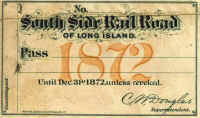 South Side
Rail Road of Long Island Pass 1872 South Side
Rail Road of Long Island Pass 1872Archive: Art Huneke |
- The excessive cost of the Bushwick outlet. The South Eighth Street
terminal could not and did not originate enough traffic to offset
the high cost of installing and maintaining the terminus. In the
beginning the breaking up of each train into car units, each drawn
by six or eight horses, must have been a very expensive operation,
and the South Side must have been compelled to maintain a stable of
horses almost as large as the average horse car line of that day.
Later, the four steam dummies cost $10,000 each and exposed the
company to a whole series of costly judgments for damages of all
kinds. Finally, we can only guess how much of the company's money
went for thinly disguised political payoffs.
- We must remember, too, that the company was forced into laying the Bushwick road twice over, once with T rail and once with grooved rail, and each time a mile and a half of pavement had to be replaced. Even in terms of 1870 labor costs this must have been an expensive business.
- The extension into Hunter's Point: To effect an outlet to the East River, a point of pride with the South Side RR, they built not only the enormously costly Williamsburgh terminus, but the duplicate Hunter's Point terminal. The company had to buyout the New York & Flushing RR's track at $40,000 a mile and then completely rebuild the road. Then, after all this expense, Oliver Charlick prevented the company from running any revenue trains over the new extension for many months by cutting off access to the property and refusing to release the Long Dock.
-
The double tracking of the road. The installation of a second track on any road is virtually equivalent to building it twice over, for it necessitates doubling the width of the graded area and doubling the size of all the bridges and culverts. When one considers that the South Side RR was running at its peak only nine trains a day each way, it is obvious that the second track was a luxury not strictly justified by the traffic. To gratify a foolish vanity, the South Side RR was forced to assume a third mortgage of half a million dollars, the interest on which could only add to the burden of fixed charges on the road.
- Competition of other roads. From the opening of the road in October 1867 to June 1872, the South Side RR enjoyed the advantage of a monopoly of the traffic on the south side and to Rockaway. The first serious inroad into the South Side's prosperity was the opening of the Long Island Railroad's Rockaway Branch in June 1872. Oliver Charlick's route was slightly shorter and more direct, and from Cedarhurst to Far Rockaway exactly paralleled the South Side tracks. After the July 1875 wreck at Lawrence much of the traffic went via the safer Long Island road. With the opening of the Central RR of Long Island in January 1873, the Southern had to compete for the traffic of Hempstead and Babylon. Thus by 1873 the South Side could be sure only of the patronage of the smaller south side villages west of Babylon.
As soon as the receiver took over the management of the South Side RR, he abandoned the Hempstead Branch as an economy measure, the only such part of the South Side system to be sacrificed. On Wednesday evening, April 30, 1879 the last train ran from Hempstead to Valley Stream. The South Side RR's valuable main line, a big money maker because of the summer trade, continued to bear the Southern RR label only until December 1879, when the owners, Drexel, Morgan & Co., reorganized it as the "Brooklyn & Montauk RR," which was then leased to the Long Island RR. Finally, in March 1880, the receiver issued an order erasing the road's identity completely. As of that month, the whole Southern RR was, in the future, to be referred to simply as the Montauk Division of the Long Island RR and so it remains to this day. In October 1889 the Brooklyn & Montauk RR was formally merged into the Long Island RR and the subsequent history of the old road becomes the history of the Long Island R.R.
Roster of Equipment
- ENGINES
- 1, 2, 3, Hinckley, 1865. The Hinckley records state that three engines numbered 1, 2, 3, were sold to the South Side R.R. Nothing further is known about them.
- CHARLES FOX, Mason, spring, 1867; Operating in July on construction trains; later LIRR 16.
- DANIEL T. WILLETS, Mason, 1868; Arrived in Jamaica on April 4, 1868; later LIRR 18.
- ALEX McCUE, Mason, 1868; Arrived in Jamaica on May 23, 1868; later LIRR 23.
- JOHN TAPPAN, Mason, 1868; Arrived about May 1, 1868; later LIRR 20.
- B. JOHNSTON, Grant, 1868; Arrived about May 1, 1868; "Weight twenty-six tons; patented gas-consuming boiler"; later LIRR 41.
- R. O. COLT, Mason; Arrived in Jamaica May 23, 1868; later LIRR 21.
- PEWIT, Danforth & Cooke; Arrived August 1869; Built originally for the Central RR of New Jersey. Built 1860.
- FIRE FLY, Danforth; later LIRR 19.
- A. J. BERGEN, Danforth; about April 1870; later LIRR 17.
- FRANCIS B. BALDWIN, Grant; late 1869 or early 1870.
- A. McLEAN, make unknown; mentioned once in July 1871, perhaps bought in 1870. Possibly a rented engine from the U.S. Rolling Stock Co.
- SOUTH SIDE, Rogers (?), probably spring of 1872; later LIRR 26.
- SPRINGFIELD, Manchester; probably spring of 1875; later LIRR 27. Built for the Southern Ry. as No.9.
- MASSAPEQUA, Grant; arrived August 1870; weight 35 tons; made speed run of sixty-five miles per hour in September 1870.
- MERRICK, The Charles Fox, renamed to Merrick by the Shipherd management. LIRR 16
- NORWOOD, make unknown; delivered probably about 1872, involved in July 1875 wreck.
-
ISLIP, Brooks; delivered probably April 1873; later LIRR 14.
- PATCHOGUE, Brooks; delivered April 1873; later LIRR 15.
- MONTAUK, Schenectady; delivered May 1873, Renamed the Creedmoor by the Poppenhusen management as early as September 1878; later LIRR 32.
- RENTED ENGINES
- CANTON, owned by Louis Broad, the contractor on the New York & Hempstead RR at Bay Ridge; taken by the South Side RR until Broad's widow, Martha, sued the railroad for repossession, and recovered it in April 1874. During periods of peak traffic the SSRR rented both engines and cars from the United States Rolling Stock Co.
- ESSEX, Probably rented from the United States Rolling Stock Co. Mentioned as derailing at Richmond Hill in July 1872.
- DUMMY ENGINES
- CITY OF BROOKLYN, Schenectady Loco. Works; placed in service on July 31, 1869. Used until February 1876.
- CITY OF BRESLAU, Schenectady Loco. Works.
- NAMES UNKNOWN, three built also by the Schenectady Locomotive Works; No. 1 built April 1870. No. 2 in Sept. 1870, No. 3 in May 1871, and No. 5 in June 1873. A dummy engine sold on December 28, 1871, in the yard of the Bushwick depot.
- COACHES
- The builders and number series of the passenger coaches purchased between 1867 and 1873 are unfortunately unknown. For the final large purchase made in 1873 we have some slight information: Sixteen coaches were bought from the New Haven Car Co. These had elaborately frescoed ceilings, panels of satinwood and seats upholstered in velvet. The undercarriage was provided with double truss rods and truss beams, also self-coupling Miller platforms.
- NEW YORK AND HEMPSTEAD R.R.
- ENGINES
- WILLIAM L. WOOD, built by Grant in 1870. The boiler blew up in 1871 and the whole engine was badly wrecked in the accident at Norwood in February 1875, but the locomotive was rebuilt.
- COACHES
- Two coaches built by Jackson & Sharp in 1870. Both were taken over by the South Side RR in September 1874 and transferred to the Central RR of Long Island.
- RAILROAD STATIONS
South Eighth Street: Built September 1868 and opened for service November 4, 1868. In July 1869 the station must have been adequate for two or three trains, for, in a letter of complaint, we read: "...the intersection of South Eighth Street and Kent Avenue is impassable...by reason of the frogs and switches and the crossing rails of the South Side RR. The company has abolished the sidewalk and occupy the space with trucks and wagons unloading directly into their depot."
In April 1872 the depot was enlarged by an extension of the roadbed on heavy framework resting on piles to the bulkhead line of the river, nearly 100 feet in length, and giving standing for several additional cars.
In a description of the waterfront in 1872 we read: "The South Side Railroad depot is deserving of mention; it was originally a depot building two stories high, in which are sitting rooms, freight and ticket offices on the first floor for the accommodation of passengers, while on that above are the several offices of the corporation. Early in summer a covered depot to shelter the cars was erected and has just been completed. This rests upon piles and partly extends over the ferry piers."
South Eighth Street station was abandoned on February 29, 1876, the last train pulling out on the twenty-sixth. All rails were removed during May 1876. Part of the old depot buildings were still standing in 1922.
Bushwick: Opened July 18, 1868. The South Side RR used the old Schenck farmhouse of Revolutionary vintage for its office; a large marshalling yard was laid out but no depot was erected during South Side days. No effort was made to improve Bushwick station until it became the new terminus in March 1876. The company then planned a large covered passenger depot, additional freighthouses and side tracks to permit horse cars to drive into the covered station area and unload passengers. In 1876 toward the end of South Side days, the Eagle remarked: "The depot, as at present it appears, is an unprepossessing object, and were it not for the tracks, trucks and railroad carriages in the vicinity, might be mistaken for a dog kennel, for a dog kennel would most unjustly suffer by the comparison. It is the meanest of many mean buildings in the neighborhood and its size dwarfed by an ordinary railroad car; it has brown weather-beaten boards; in front of it is a little platform, and alongside this the train stands. Altogether it might do for a wayside station..."
Changes in management postponed the planned improvements, but rebuilding began in May 1877 under the Poppenhusens.
Hebbard's: Appears as a station only on the timetables of May, June and August 1870. There was probably no depot building. Named after the Hebbard farmhouse on Flushing Avenue at about Fifty-second Street. This district was known at the time as Metropolitan or East Williamsburgh. The name is often misspelled "Hibbard's."
Fresh Pond: Nothing is known about the date of erection of the station; it does not appear on the timetable until June 1869. The original wooden building was still standing in 1923.
Glendale: First appears on the timetable of June 1869. Nothing is known about the presence or absence of a station.
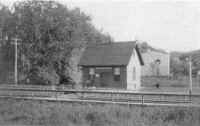 SSRR
Glendale Station c. 1869
Archive: Art Huneke
SSRR
Glendale Station c. 1869
Archive: Art Huneke
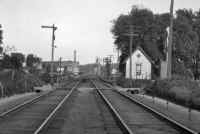 SSRR
Glendale Station with Tower #9 (later "GW") is visible in the
distance View E 1906 The tower was placed out of service in 1908.
SSRR
Glendale Station with Tower #9 (later "GW") is visible in the
distance View E 1906 The tower was placed out of service in 1908.
Archive: Dave Keller
Richmond Hill: First appears as "Clarenceville" on timetables of July 1868. Station building put up during April and May 1869, partly with funds raised by the citizens, and many shade trees were added to beautify the grounds. Beginning July 25, 1869 President Fox and the directors permitted the building to be used as a chapel on Sundays. The name of the station was changed to Richmond Hill in October or November of 1871. The original depot building survived until the grade crossing elimination at Jamaica Avenue in 1923-24.
Van Wyck Avenue (Berlin): First appears on the timetables of June 1869. A station building was erected in July 1870. Name changed to "Berlin" on timetable of May 1871. Discontinued in June 1876 by LIRR on assuming the South Side RR management.
Jamaica: The original South Side depot was located between the Long Island RR on the north and Beaver Pond on the south, or, in present-day terms, on the north side of Beaver Street at 151st Street. A newspaper comment of November 1869 remarked on the poor appearance of the station and the area; the approaches were poor and the station itself seemed a temporary affair with a hut beside it for handling freight. The company declined to do more unless assisted with public funds. In September 1871 a public subscription was under way and a larger building planned. As built, it was 22 x 48 (14 feet high inside) with two rooms, ticket office, etc. The cost was roughly $2000 of which $700 came from the village donations. On Christmas morning of 1871 the new building was opened and the original sold for $180 to a resident.
In May 1877 the Long Island RR moved the South Side station into its yard just west of the Long Island station. In the third week of July 1877 all trains ran into the Long Island depot at Jamaica, and the South Side facilities abandoned.
Locust Avenue: First appears on the timetable of June 1869 presently Locust Manor station at Baisley Blvd. Abandoned by LIRR June 1876 on taking over the South Side R.R. management.
Springfield: One of the original stations. Located at Springfield Boulevard east of the road and north of the railroad. There was probably a station building here. The settlement lay to the north near the Merrick Road. Station abandoned by LIRR in June 1876 on their taking over the South Side R.R. management.
Foster's Meadow (Rosedale): First appears on the timetable of May 1870. Located at the present Hook Creek Blvd., just east of the present Rosedale station. The station building was begun on June 20, 1871 and finished about a month later. Village name changed to Rosedale in 1892.
Valley Stream: First appears on the timetable of June 1869. A wholly new community personally developed by Electus B. Litchfield of Babylon, who acquired the land in the fall of 1868. Post Office opened April 1870. Plans were laid for a depot in August 1869, and in the summer of 1870 several prominent residents offered to put up half the cost of a station, but then reneged. The men who were at work on the building at the time rioted at the news, and to restore peace, the South Side RR paid the whole cost of the station itself. The building was located between Third Street and Rockaway Avenue on the south side of the tracks.
Pearsall's (Lynbrook): One of the original stations. First "Pearsall's Corners" until April 1875, thereafter simply Pearsall's. Located between Hempstead Avenue and Forest Avenue on the north side of the railroad. In January 1870 the citizens voted to change the name of the village to Pearsallville. In 1893 the village changed its name to Lynbrook.
Rockville Centre: One of the original stations. No details of the depot are mentioned in old sources. Station located on the east side of Village Avenue and north of the railroad. Place originally was referred to as Rockville after the "Rock" Smiths who settled there, but by late Sixties name Rockville Centre was in use.
Baldwins: One of the original stations; appears as Baldwinville and Baldwinsville beginning in 1869 and continuing through 1871. On the table of July 1872 it is first listed as Baldwins and so continues into the Twentieth century. Depot building erected by townspeople in February 1868, a "commodious building and creditable to the place." During the summer of 1868 the village name was officially changed to Foxborough to honor President Fox, but this did not last. Later, about 1890, Austin Corbin, LIRR President, pushed through a change of name to "Milburn," but after his death the name of Baldwin was restored.
Freeport: One of the original stations. There is no account of the building of the depot in any of the old newspapers, but construction probably took place in 1867-68.
Merrick: No account is preserved concerning the erection of a depot, yet this station must have received special attention, for both President Fox and Superintendent White lived here. There was also located here a siding, engine house, and freight house. Between 1869 and 1876 several trains terminated their runs at Merrick station.
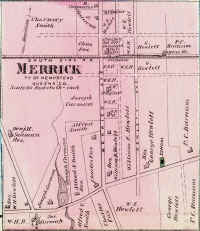 SSRR
Merrick map 1873
Archive: Art Huneke
SSRR
Merrick map 1873
Archive: Art Huneke
Bellmore: Charles W. Hayes, a real estate promoter of Williams burgh, owned in 1869 considerable land in what is today Bellmore. Through his influence with President Charles Fox, the new station of Bellmore was erected in October 1869. By December the wilderness was cleared and streets had been opened and graded. The timetable of May 1870 is the first to list the new station.
Wantagh: One of the original stations on the road. From the beginning in 1867 down to 1891 the station is listed as Ridgewood. In July 1875 the residents subscribed a sufficient amount of money to erect a depot and the site was donated by a Mr. F.R. Rogers. The village has changed its name four times. It was first referred to as Jerusalem South, but came to be constantly confounded with Jerusalem Station. Then the name was changed in the Seventies to Atlanticville but it was soon discovered that a village in Suffolk County already bore this name (now East Quogue). Again the name was changed to Ridgewood, but by this time Ridgewood in Queens County had begun to use that name. Finally, in desperation, the residents in May 1891 changed the village name to Wantagh, after the sachem of the Merrick Indians in 1747, and so it has remained.
Massapequa: The locality was originally known as South Oyster Bay, because that township owns the narrow strip on the south shore enclosing the present-day villages of Seaford and Massapequa. This was one of the original stations in 1867. In April 1870 a German real estate society laid out 1500 acres and named it Stadt Wuertemberg, a boom made possible by the railroad. The depot is supposed to have been donated by the Floyd-Jones family, who owned all the land in the area.
SSRR South Oyster Bay Station c.1890 Archive: Art Huneke
Amityville: The depot building was erected in November-December 1868. The village was one of the original stations on the road.
Lindenhurst: Thomas Wellwood, a real estate promoter, bought the village land in 1861, and was joined by Charles S. Schleier in October 1869, who renamed the new development after his native Breslau in Prussia and boomed it as a German colony. The village first appears on the timetable of September 1, 1868 as Wellwood and so remains through 1869. In May 1870 the station appears as Breslau. In June 1891 the Hon. Benjamin F. Tracy, owner of much of the shore-front acreage, successfully lobbied a petition through the Post Office Department to change the name to Lindenhurst, and the railroad station was so changed on July 14, 1891.
SSRR Breslau Station Left is Nehring's Hotel, Wagner Building. At right Gleste's Hotel-bank building - View E 6/06/1870 Archive: Dave Keller
Breslau Station SSRR 1870
Bayshore: First appears under its old name of Penataquit on
timetable of May 20, 1868. In July 1868 the name Bay Shore first appears.
 SSRR Bay Shore Station c. 07/1868 Archive:
Art Huneke
SSRR Bay Shore Station c. 07/1868 Archive:
Art Huneke
Islip: First appears on the timetable of May 20, 1868 as the terminal of the road and so remains until September 1 timetable. Between December 1, 1868 and June 1869 a second station was maintained at Islip Centre, probably the present Brentwood Road, but on August 19, 1869 the railroad loaded the little 20 x 30 feet depot on a flat car drawn by the engine Pewit and carted it eastward, leaving Islip the sole station in the village.
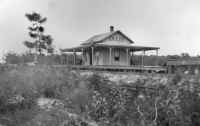 SSRR Islip Station c. 05/1868 Archive: Art Huneke
SSRR Islip Station c. 05/1868 Archive: Art Huneke
Club House: First appears on the timetable of May 1870. Inside the present Bayard Cutting Arboretum grounds, on the west bank of Great River and south of the Montauk Highway. The station was maintained for the South Side Sportmen's Association for many years, and stood midway between the present Great River and Oakdale stations.
 SSRR Club House Station c. 05/1870 Archive: Art Huneke
SSRR Club House Station c. 05/1870 Archive: Art Huneke
Oakdale: First appears on the timetables of December 1, 1868. Nothing is known about a depot.
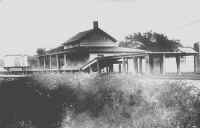 SSRR Oakdale Station c. 1868 Archive: Art Huneke
SSRR Oakdale Station c. 1868 Archive: Art Huneke
Sayville: First appears on the timetable of December 1, 1868. In December 1868 an engine house was completed at the station. In October 1869 a freight house and wooden station platform were erected at Sayville station.
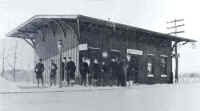 SSRR
Sayville Station c.1868
Archive: Art Huneke
SSRR
Sayville Station c.1868
Archive: Art Huneke
Bayport: First appears on the timetable of December 1, 1868. In March 1869 the local residents built the depot building themselves with materials supplied by the railroad.
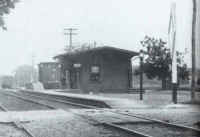 SSRR Bayport Station c. 12/1868
Archive: Art Huneke
SSRR Bayport Station c. 12/1868
Archive: Art Huneke
Blue Point: First appears on the timetable of May 1870. The Bayport post office was located in Blue Point in 1870. The South Side Signal of June 27, 1891 says the station was opened February 1, 1870 and was closed June 1, 1882.
 SSRR Blue Point Station c. 01/1870 Archive: Art Huneke
SSRR Blue Point Station c. 01/1870 Archive: Art Huneke
Patchogue: Depot building put up in July-August 1869 by William Homan, the road's master carpenter. It was 220 feet in length "large and commodious and in appearance an honor to the company and an ornament to the place."
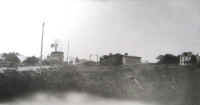 SSRR Patchogue Depot c. 1869
Archive: Art Huneke
SSRR Patchogue Depot c. 1869
Archive: Art Huneke
- ROCKAWAY BRANCH
Cedar Grove: Appears only once on the company timetables: June 1869. Older name of Hewletts.
Hewletts: First appears in October 1869. Nothing is known of the depot here. During the Nineties it was for a time called "Fenhurst."
Wood's Station or Woodsburgh (Woodmere): First appears as Wood's Station on table of October 1869, but thereafter as Woodsburgh. The village was laid out in 1869 by Samuel Wood, who built the depot, houses, streets and a hotel called the Pavilion. In the early nineties there was a movement to change the village name to "Glenhurst" but nothing came of this.
Ocean Point (Cedarhurst): First listed on table of October 1869. No depot building existed at first, but in 1873 Mr. Thomas E. Marsh, owner of several hundred acres of land at Ocean Point, cleared and laid out a village, and built the railroad station in July 1872. Station abandoned by the LIRR in June 1876 when it took over the South Side R.R. management.
Lawrence: First listed on timetable of June 1869. The village was developed at the time of the railroad extension and was named for Newbold and Alfred Lawrence, its promoters. No details are known about the depot.
Far Rockaway: First listed on the timetable of June 1869. No information on depot facilities in contemporary newspapers.
Beach, or Beach House, or South Side Pavilion: First listed in May 1870. On the timetable of July 1872 the name is changed to South Side Pavilion. In 1876 this seaside terminal building was sold by the railroad. The old depot appears to have been located very near the water at about Beach Thirtieth Street.
Eldert's Grove: First listed in July 1872. The recent Hammel's station at Beach Eighty-fourth Street operated until the end of LIRR operation.
Holland's: First listed July 1872. The present Holland's station at Beach Ninety-Second Street.
Sea Side House: First listed July 1872. The present Seaside station at Beach 103rd Street.
Neptune House: First listed May 1875. The present Rockaway Park station, Beach 116th Street.
Atlantic Park: First appears in May 1875, being listed after the South Side Pavilion station, and continues to the end of South Side RR days. Probably at a point along Atlantic Avenue midway between the present Far Rockaway and Edgemere stations.
- HEMPSTEAD BRANCH
Bridgeport: At Franklin Avenue, Malverne. No station building here
Norwood: Hempstead Avenue at Cornwell Avenue. No station building here.
Hempstead: On west side of Greenwich Street midway between Front Street and Peninsula Boulevard. After abandonment of the station in May 1879, the depot building was converted into a skating rink, but it burned to the ground in early July 1888.
ADDENDA
[A typed slip of paper labeled "ADDENDA" was included with the book.]
- A recently discovered list of liens against the South Side R.R. as
of September 1874 mentions two locomotives by number and name:
- #16 the "Rockaway"
- #17 the "Islip"
- #16 the "Rockaway"
- The locomotive "Montauk", rebuilt after the wreck of July 1875, emerged from the shops in September 1875 as the "Glendale"
This work is in the public domain in the United States because it was legally published within the United States (or the United Nations Headquarters in New York subject to Section 7 of the United States Headquarters Agreement) before 1964, and copyright was not renewed
